
|
Home DH-Debate 34. Valdemar the Great 36. Valdemar the Victorious |
Adam of Bremen writes about Hardegon, son of Sven, and a little later about Hardecnudt Wurm. Some historians believe that a "filius" is omitted from Adam's text, so that it snould have said "Hardecnudt filius Wurm", which would mean "Wurm, Hardecnudt's son". It is supported by the fact that Canute the Holy in his gift letter to the cathedral in Lund from 1085 calls himself Knud 4., from which follows that there must have been a Knud 1. or a Hardeknud 1. prior to Gorm.
The first Knud was thus Hardecnudth, son of Hardegon, the latter probably came from Viking area in England and conquered much of Jutland around 917. The second Knud was Canute the Great, who ruled both Denmark and England. His son Hardicanute was the third Knud. Canute the Holy was the fourth, and Magnus the Strong's son, Knud, who fought against Svend and Valdemar was the fifth. Therefore, Valdemar the Great's son, Canute, could call himself Canute the Sixth.
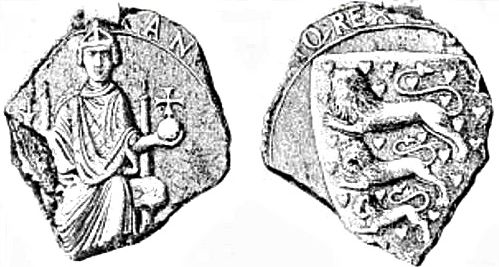
Canute the Sixth's seal from about 1190 contains the earliest known depiction of Denmark's coat of arms with the three lions and a number of hearts. The only known copy of this seal was found in 1879 in the Grand Ducal Archives in Mecklenburg-Schwerin, Germany. Note the king's closed crown, which deviates from the crowns on his successor's seal. If we are to believe in any portrait-likeness, the king was a long-skulled type with a narrow face.
It was very important for kings and throne candidates that they descended from former kings and therefore kings and princes of that time had complete control of information of their family.
Another example - In 1798, historian and book collector Peter Frederik Suhm found it strange that Erik Ejegod called himself Erik 3. But Erik Ejegod also had complete control of information about his ancestors. We can read in "Vita Anskarii": "While Ansgar stayed in Sweden, the prospects for successful missionary work in Denmark faded. Erik, the King of Jutland, who had previously supported Anskar, had become unpopular with his pagan subjects, and in a battle that lasted for three days he and almost all his leading men were killed, and his only descendant, Erik 2. remained as a regent over only a small part of Jutland." Which makes it likely that also Hardecnudth, son of Hardegon considered himself as a descendant of the kings of an original Jutland kingdom between the Angles and the river Kongeåen as the Venerable Bede clearly states that the Jutes lived "north of the Angles", at a time when this peninsula was called Gotland and was home to many other indigenous tribes and peoples.

|
Royal dynasties through Denmark's history. However, all Danish kings, with the exception of Magnus the Good, descent from "Hardegon, son of a certain Sven", who conquered a big part of Jutland around the year 917 as told by Adam of Bremen in his section of bishop Hoger. But it gives a good overview to divide the line of kings - and thus the history of Denmark - into manageable sections. The line of kings and tales of war and peace is the backbone of history - not so that accounts of culture and ordinary people's living conditions are not important, but without the line of kings they can easily become unstructured tales that are not easily placed in time.
The Knytling genus got its name from Hardecnudth, most likely son of Hardegon. He is also called Canute 1. and was perhaps Gorm the Old's Father, told by Adam in the section of Unni. Magnus the Good, who was king in 1047, was the son of the Norwegian saint king Olav; his reign forms a transition to Svend Estridsen and his sons' and grandsons' time.
The warring kings, Svend, Knud and Valdemar, around 1157, were all descendants of Sweyn Estridson; their time is an interregnum to the Valdemars' era.
Many historians, probably most, only recognize Valdemar the Great, his son Canute the Sixth and Valdemar Sejr to the Valdemars. But one cannot claim such a definition, and it seems appropriate for the author to include their less successful direct descendants - including Erik Plovpenning, Abel and Christoffer 1. - until Christoffer 2. who was the last king before Denmark's period without king around 1340.
Valdemar Atterdag was not king of the Kalmar Union, but his grandson, Olaf, was and his daughter Margrete 1. became the reigning queen of the Scandinavian Union. One can say - with a little good will - that Valdemar Atterdag reestablished Denmark and thus the possibility of the Kalmar Union with Norway and Sweden.
The early Oldenburg kings were also Union kings but only for shorter periods.
The Civil War The Count's Feud in 1536 was a crucial turning point in the history of Denmark. As a result of the Lutheran Reformation, which took place at the same time, the kings seized the third of Denmark's agricultural land that belonged to the church. This fabulous wealth made it possible to overcome Denmark's old nobility and create the absolute monarchy, which was an important reason for Denmark's historical deroute.
In 1848, a democratic constitution was introduced without civil war or other acts of violence.
The Oldenborg royal line became extinct in 1863 with the childless Frederik 7. The throne was then taken over by Christian 9. of Glucksborg.
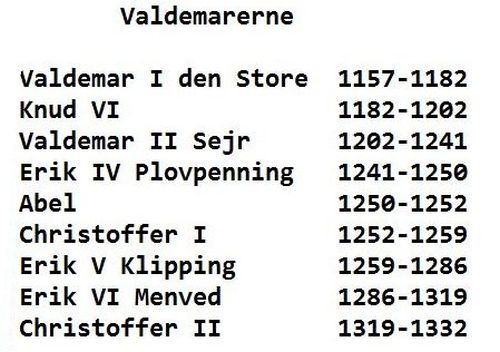
The Valdemars. It is common only to count Valdemar the Great, Canute the Sixth. and Valdemar Sejr to the Valdemars. But in doing so, their less successful descendants become educationally homeless, despite being direct descendants of the first Valdemars, and they are not separated from these by any natural transformation period. Therefore, I will suggest the whole group until the kingless time to be called the Valdemars.
Erik Plovpenning, Abel and Christoffer were sons of Valdemar Sejr and succeeded each other as kings. Probably Abel killed his brother Erik and immersed his body in the fjord Slien. However, 24 knights swore that Abel was innocent and therefore he could still be elected king. But after a short time he was killed in battle during a campaign in Frisia, and then his little brother Christoffer was chosen as his successor as king, and Abel's eldest son was thereby passed. This led to a long-lasting rivalry between the descendants of Abel and Christoffer in the following decades.
Christopher's son, Erik, bynamed Klipping, became king only 10 years old with his mother Margrete Sambiria as guardian. The chieftains limited his power with a treaty at the meeting called Danehof at Nyborg Castle, which stated that the assembly of the king and the nobility, later called the Danehof, should be the country's highest court. In addition, it was settled that the royal court should not deal with cases that had not previously been presented for another court and that it should only impose standard penalties. Erik was killed in Finnerup Lade near Viborg with 56 stab wounds - one of the great mysteries of Danish history. His son Erik Menved sought to create goodwill and increased influence in Northern Germany by arranging some costly knightly tournaments. He was followed by his brother Christoffer 2. who had to take over his brother's large debts, while he was blocked the possibility of increasing the crown's tax income by a treaty. When he died in 1332, no new Danish king was elected, and the country was for a period without king.
Immediately when Knud became the sole king at the death of his father in 1182, a rebellion broke out in Scania led by a certain Harald, possibly a son of Olaf, the only survivor of Harald Kesja's many sons, who was briefly king of Scania. The rebellion was quickly defeated by local officials and Absalon with warriors from Sjælland. The young Knud wanted to punish the rebels harshly, but at Absalon's intervention they escaped by paying fines.
But when peace had settled over Scania, a new problem arose in the form of repeated emissaries from the emperor, who asked the new king to appear at the imperial court to seek the emperor's friendship, "as his father had done". Knud answered dilatory, triggering a new letter full of threats. After careful deliberation with his advisers, Knud replied that "that the King of the Danes does not intend to show his Imperial Majesty the slightest obedience".
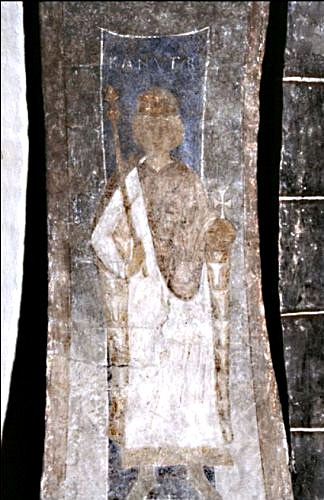
Knud the Sixth on fresco in Stehag Church in Scania north-east of Lund. He has no saintly glory, therefore he cannot be one of the two Canutes, who are saints, and he wears the distinctive closed crown that he also does in his seal. Photo Sven Rosborn Wikipedia.
The emperor then ordered his vassal Bugislav in Pommern to attack the Danish possession, Rügen. He gathered a large fleet from the Eastern Venden in the waters off the Pommern and awaited a similar fleet from the Western Venden. Jarimar, King Knud's governor at Rügen, sent a messenger to the king about the danger that was coming up. With furious speed, Absalon gathered a fleet from Fyn, Sjælland and Scania consisting of the ships that could be scraped together in haste. The Danes attacked singing in dense fog with waving banners, and the Slaws did not see them until they were quite near. It was an overwhelming Danish victory.
The following year, a large Danish navy attacked Bugislav's kingdom. He surrendered himself by swearing allegiance to King Canute and taking his kingdom as a fief from him and thus the Danish kingdom came to include Pommerania. Over the following years, the Danes conquered the rest of Pomerania and Knud could then call himself "King of the Vends". King Knud then came into possession of Mecklenburg, Holstein was completely conquered, and the kingdom of the Danish king then extended to the Elbe and eastward along the Baltic Sea coast.
Bishop Valdemar, a son of Knud Magnusson, appointed himself king and attacked Denmark. He was defeated and imprisoned, but the episode triggered complications with the Pope because Denmark had imprisoned a bishop.
King Knud worked to improve the country's laws. During his reign, the law of Scania was written down. the Vederlaw, the law of the hird, which governed the king's armed retainers relations among themselves, was established and described by both Saxo and Svend Aggesen.
Already two years after his birth, the young prince was hailed as king during a leding raid against the Pomerania. As a seven-year-old boy, he was solemnly anointed, crowned, and put on a purple robe as his father's co-king. It was the first Danish real coronation ceremony that took place in Ringsted in great glory in the year 1170. Former Danish regents were kings of the people's will, but by letting the archbishop crown and anoint the young man, Valdemar wanted to emphasize that he should be king of God’s grace and not dependent on the whims of the people.
So, from his infancy, Prince Canute knew that he was destined to be something great; One would think that it also created an enormous pressure of expectations that could have ruined the best. But everything seems to indicate that Knud resisted the pressure and stood up to expectations. His reign was a golden age for Denmark of peace and prosperity.
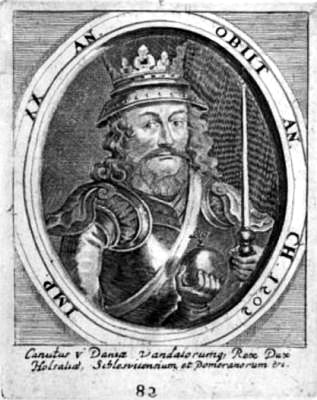
Canute the Sixth of Engraving from 1685. There is, in all probability, no portrait likeness. From the Royal Library.
Admittedly, Valdemar had a much older son named Kristoffer, but for the first time in the history of Denmark an older son was disregarded because he was born out of wedlock. Further, Kristoffer died young, ten years before his father.
Arnold of Lubeck praises Knud for ruling his kingdom with great seriousness, which had been ruled by several kings in the past. He "ruled himself in his own person the kingdom, which his father, however, needed great effort and prudence to come into possession of."
Several historians describe, as a given thing, that Knud was a weak-willed young man who was controlled by his advisers, especially Absalon. In addition to Absalon's fame, this assessment apparently rests solely on a single place at Arnold of Lubeck, where he describes Canute as a very serious man, burdened by his royal duties: "Also in matrimony however, there are many people who conscientiously take care of their vocation, are careful to show hospitality, are careful to give alms, keep fidelity in their marriage, is zealous in prayer and give all other requirements of righteousness satisfaction. Here I just have to mention the king, whose whole way of living, though still in his heyday, still stamped him with the mark of such an age that one might be tempted to regard that word of "Wisdom" as explicitly coined on his seriousness: "An honorable old age does not consist in a long life and is not measured by year". Thus, he did not use that youth otherwise have the custom, to run after games or plays, was not keen to make excursions or strolls, nor devoted to excesses, but "chastest even with his chaste wife lived his days". When Mass was celebrated, he did not indulge with in whispering or mking fun as several others have custom to do, but devoted his mind completely to the hymnbook or another prayer book. And because his heart hung on the "Wisdom", which says: "By me kings reign", therefore, the Lord also fortified his kingdom so that, in the time of his ancestors three, even four princes shared the Danish between themselves, he himself ruled in his own person the kingdom, which, however, his father needed great effort and prudence to come in possion of."

Absalon on fresco in Fjendeslev Church between Ringsted and Sorø. Absalon was a skilled and experienced army commander, one of the heroes of the Fatherland, and probably Knud the Sixth's most important adviser. Photo Pinterest.
But Arnold simply thought that Knud was almost unnaturally serious in everything he did, his age taken into account. Nowhere does he suggest that Knud was a weak-willed person, completely controlled by his advisers. Knud was certainly a very serious king, but it can hardly be blamed him.
Arnold says: "Kanut, in whose realm there was the deepest peace, estimated, however, that in the days of his fathers the Slaws had inflicted many losses on his country; and, moreover, seeing that they had lost the assistance formerly rendered to them by Duke Henry, who had tamed their jaws with his iron will, he seized the opportunity to wage war upon them, but followed in his struggle against them the advice of Archbishop Absalon and thus became their superior by cunning rather than by force."
However, it is not in itself a sign of weakness that he took his job as king with the utmost seriousness. It may be a sign of anxiety, but there is no evidence that he was paralyzed with doubt and fear. Moreover, listening to experienced advisers is not a weakness either - on the contrary, if he had rejected good and relevant proposals for decisions, merely to demonstrate his power and reputation, it would really have been a weakness that the enemies would have exploited. Furthermore, counselors can often disagree, and it takes intelligence and determination to choose the right advice. Under Canute there was peace and prosperity in Denmark. As Arnold says "in whose kingdom reigned the deepest peace" , and under Canute the kingdom of the Danes achieved its greatest extent hitherto, which must indicate that he made the right decisions.
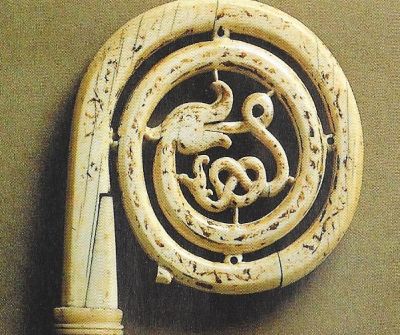
Detail of crozier from the the 1200's. It was carved from walrus tusk, safe from Greenland. The dragon motif points back to the Viking Age. It probably belonged to Absalon, but it could also have belonged to the abbot in Sorø Monastery, which also had the right to bear the crozier. Photo Nationalmuseet.
It is easy to imagine that the Slaw leaders of North Germany so willingly submitted to Knud precisely because he was virtuous and very earnestly wanted to do the right things, and they turned their backs on his successor Valdemar the Victorious because he was less virtuous, even he was very active and resolute.
Sven Aggesen also believed that Canute was not inferior to his father, Valdemar the Great: "Canute was a pious and moral man, he was upright, handsome, brave as a warrior and in alle things like his father."
Valdemar had dreamed that the king should be king by the grace of God and not by the will of the People. But that wasn't quite the case yet. After his father's death, Canute - like so many former kings - first headed for the greatest and most important ting, namely Viborg Ting in Northern Jutland. Saxo says: "When the funeral procession was over and the king put to rest in the soil with the greatest honor, Canute after his advisers encouragement as soon as possible went to Jutland to get his royal power and authority upheld." - "At Viborg Ting the people received him with all possible benevolence, at Urnehoved Ting there were some who were secretly hostile to him, but he soon overcome them, and the others also kindly accepted him, so that with the consent of the people of the country he was recognized as heir to the kingdom."
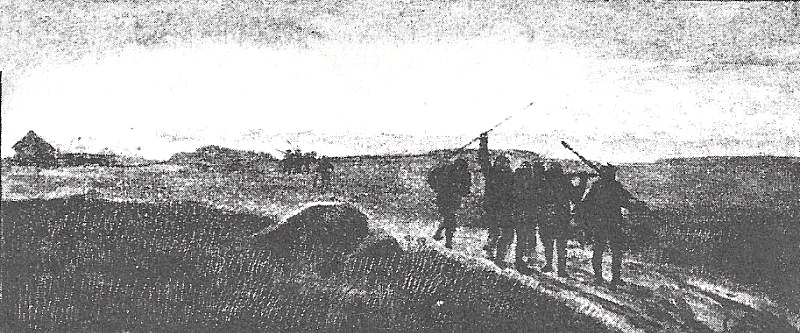
|
Valdemar the Great's funeral procession. Drawing Louis Moe.
But the Scania people could not forget Absalon's requirements for Bishop-tithe and the peasants' subsequent defeat at Dysieåbro. Saxo writes: "A man named Åge Tuesson breathed with his poisoned speech to the fire and once again caused the muted and almost extinguished rebellion in Scania to break out into flames. To prevent this calamity, Absalon went over to Skane, where he spoke boldly to the malicious commoners, but without succeeding in anything, for they left him and went to the leaders of the rebels, who held ting elsewhere and were so arrogant and rude that they rode around and asked all of the Scania commoners to meet armed in the same place again, when the sowing time was over, to defend their freedom."
"They (the commoners) attacked Thord and Esbern's farms, which they first plundered and then set on fire, attacked, and in the following days several other of the Scania nobility's farms also were burned."
Saxo continues: "The chiefs of the uprising, who, during the last rebellions, had experienced that they came nowhere when they did not have a leader, now summoned from Sweden a man named Harald, who was of royal blood, but both lethargic and a bad speaker and altogether completely unfit to be king, since nature or the luck in no respect had conferred upon him any advantage except his noble descent."
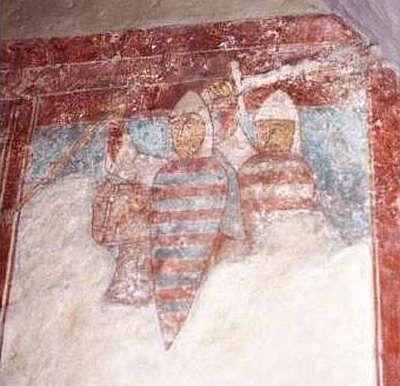
Mural painting with warriors in Vellev Church south-west of Randers. They are equipped with chain mail, spears, swords and pointed helmets and elongated downwardly tapered shields. A horizontal striped shield was the mark for a branch of the Hvide family. So maybe the warriors have been associated with them, despite the fact that the Hvide genus mainly lived on Sjælland. Photo kalkmalerier.dk.
"When he finally broke into the land with the warriors he had been given by King Canute of Sweden and Birger Jarl, the common people flockede eagerly to him by the rumor about the new chieftain, they had got and an incredible number of people gathered around him."
Saxo is the only one to have the story of the uprising in Scania: "As a result, several of the chieftains sent messages to one another, and they gathered, and after having encouraged each other, they camped at Lommeå, while others of the King's warriors failed to attend, pretending they knew nothing of what was going on. Those who had gathered, however, were so eager to fight, that they without fear of any danger, and filled with contempt for the peasants, no matter how few they were themselves, gave the horses relaxed reins and without proper leadership galloped into the enemies, all that straps and clothing could hold. In this attack, the enemies they stormed did less damage to them than the wind, which they had just into the heads, for it was so strong that it tore the shields away from them, but the peasants did not even dare to resist when they came rushing towards them, and the peasant army, which was more numerous than courageous, was thus beaten without bloodshed." - "After they were parly killed and partly taken prisoner, Harald fled home to Sweden as well as Åge who had got him to seek the crown."
"The peasants, however, were so impertinent that they had not had enough by inflicting war on the chieftains twice;" Saxo continues, "they summoned again to ting and did not hesitate to denounce them for the third time, since it was their intention to eradicate all the nobility to take revenge for the smarting wounds that had been added to them, and satisfy the raging desire for insurgency that they were possessed of."
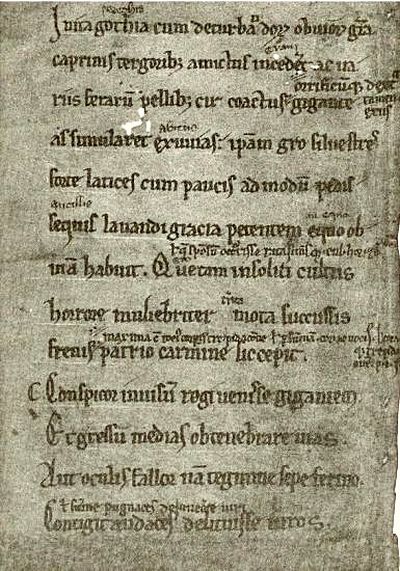
A page of Saxo's original manuscript. Around the year 1500, Christiern Pedersen began sending letters to his connections across the country to trace the lost Gesta Danorum of Saxo, which he knew had to exist. He searched libraries and monasteries, but all in vain. Eventually, a letter came from Archbishop Birger Gunnersen of Lund, stating that he knew of a copy, Christiern Pedersen could borrow. In 1514 he got it printed in Paris. In 1877 a few pages of the original Saxo manuscript on parchmentwere were sensationally found in Angers, France. It is seen that Saxo had a very neat and beautiful handwriting. He used very large line spacing to allow for corrections and additions. Photo Danmarks Riges Historie published 1896-1907.
But Absalon came to the ting with his riders: "For he came with waving banners to the place where the ting were to be held, and not only prevented the commoners from putting into action their rebellious plan, but also in the fairest and most lawful way put the laws in force again, that they with the greatest unfairness had thrown away." - "The common people were so far from daring to practice hostilities that they put down the arms and pretended they did not at all had an evil plan, mingled between Absalon people as if they only came to keep ting in all peacefulness, and eagerly expressed their applause by every verdict he made, though they were anything but happy thereby."
He ends the story of the uprising in Scania: "Thus this thing ended the terrible and long-lasting revolt, and the common people have never since dared to try to stand up tagainst the nobility." Then the peasants would lose the rest of their freedom little by little, and it would last 700 years before Denmark's peasants again became their own masters.
Saxo says that when the young Knud finally arrived, he would severely punish the rebels, but Absalon persuated him not to do it: "Here he gave Frost Herred as subject for fire and looting, and it would also have been destroyed if not Absalon, who had great goodness for it, had intervened. He managed that those who had plotted against the King by joining Harald escaped with fines."
The emperor had noticed that there had come a new king in Denmark. Saxo says: "He repeatedly sent messengers to him, ordering him to appear at his court to seek his friendship, like his father had done before him." After discussion with his advisers Canute answered politely but dilatory, as he "apologized by being so new to the government."
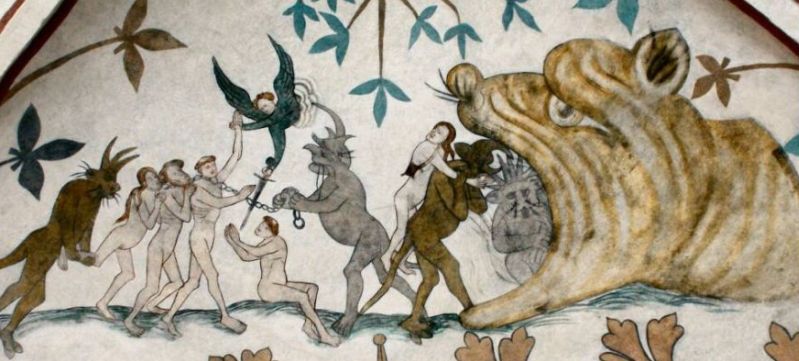
|
Mural from the 1300's in Højby Church in Odsherred showing the condemned on the way to hell. Photo Gunnar Bach Pedersen Wikipedia
"Then the Emperor sent a letter full of threats to him and told him that he would take the kingdom from him and give it to another, but the king only replied that before he took the kingdom from him, he must first find someone who wanted to take Denmark as a fief from him."
"When the emperor realized that he came nowhere this way, he got Sigfried, who was married to the king's sister, to try by persuasion to achieve what he himself did not manage by his letters. He traveled to Denmark, and after telling the King how much he loved him for the sake of being brother-in-law, and how the Emperor was such a powerful man, he began to imagine Absalom, Sune, and Esbern," - "how much allegiance they owed to Canute, whose guardians they were and how much trust his father had shown them." He asked them earnestly not to encourage "the young man, who was entrusted into their custody and who was both young of age and incapable of advising himself, to plunge into a troublesome war that exceeded his powers."
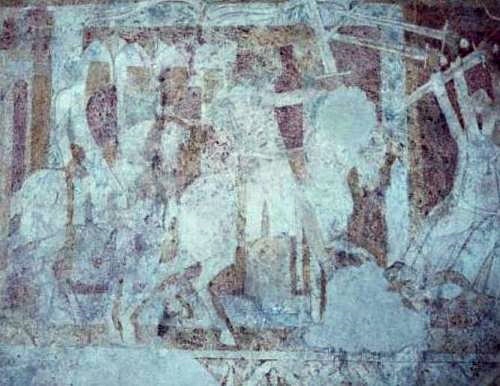
Battle scene on fresco in Hornslet Church. Photo kalkmalerier.dk.
Absalon replied that Knud actually wanted the emperor's friendship "but on such terms that it did harm his own honor and highness," and he should know "that Knud ruled his country with the same right and freedom as the emperor ruled the Roman Empire." Then Sigfried became angry and overwhelmed them with threats to which Absalom replied: "Get lost immediately and tell your Emperor that the King of the Danes does not intend to show his imperial majesty the slightest obedience."
When the Emperor received that message, he got angry against Canute for the disdain he showed him. He turned to "the Slaw Duke Bugislav, who had recently inherited his brother Kazimar, as he had died childless, and sought by numerous gifts and promises of gold and green forests to make him declare war with Denmark. Bugislav was no wiser than only too willingly to lend an ear to the emperor's request, but as he dared not openly declare Denmark war, he first sought pretext to come into conflict with his maternal uncle Jarimar, the governor of Rygen."
Saxo says: "However, Bugislav had, at the Emperor's request, gathered warriors not only at home in his own country, but also from far and wide in neighboring countries, and had acquired a fleet of five hundred fully equipped warships to go towards Rygen." - "However, Jarimar now became frighted by the war that so suddenly and unexpectedly was at hand, and sent messengers to Absalon, who was staying in Sjælland, to let him know the great danger that lurked above the head of the Rygen people."
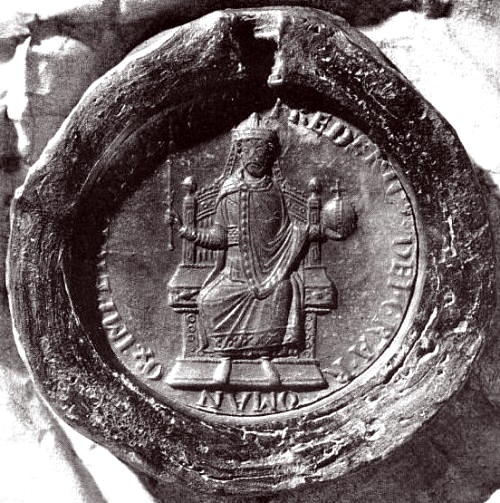
Frederick Barbarossa's seal. The Emperor, with his beard clearly visible, seated on his throne with lily scepter and orb, crowned with a crown with three shackles and pendilia. The text says: "Frederic Dei Gra Romanor Imperator. Photo De Rode Leeuw.
Knytlinge Saga tells why Bugislav hesitated to attack and thus gave the Danes the opportunity to mobilize: "When the Rygians experienced this, Jarizmar sent men to Archbishop Absalon to tell him that the Easterners had a large fleet out, and waited for the Westerners, intending to ravage them; he asked the archbishop to help them if he wanted to keep the land."
Speed and determination were Absalon's specialty: "Absalon sent, with the persistence needed to prevent allies from being beaten, letters all over Sjælland and invited anyone, who was old enough to carry weapons, to join the fleet. He assembled large and small ships, cargo ships and warships among each other, and allowed the common people and the nobility to take over the ships they could get hold of. He sent the same message to the islands around Sjælland, but he ordered the Fyn people and the Scania people to arrive in the port designated for meeting place within six days, otherwise they could stay home." The Danes gave Absalon full support: "However, they, who obeyd his command and inteded to take part in the expedition, were so eager that they competed in leaving quickly to such an extent that many came before the appointed time had expired, and none too late."
Exactly at this time Canute was in Jutland and had no opportunity to take leadership of the expedition: "However, although message was sent to him in Jylland, Canute could not take part in Absalon's venture because of the long way he had and the scarce time set."
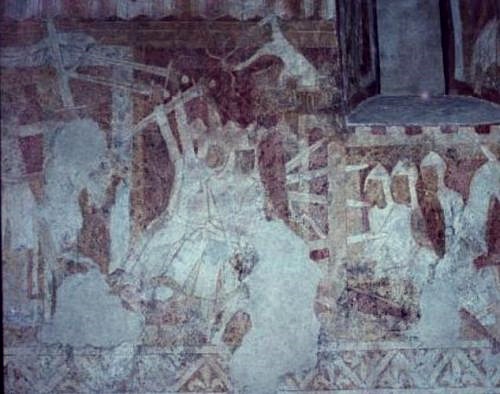
Battle scene on fresco from around 1200 in Hornslet Church between Aarhus and Randers. A group of warriors dressed in chain mail and helmet and armed with swords attack a castle. At the top, an archer shoots the attackers. Photo kalkmalerier.dk.
Saxo continues: "It was the day before Pentecost that Absalon's fleet gathered in the harbor where he had asked it to meet, and for no time to waste he broke up that same day and sailed to Hiddensø. Some envoys from the Rygen-people came to the fleet and asked them to wait, until one could get information on which part of the Rygen the enemies intended to attack. Because Bugislav had anchored at Kostø (maybe Insel Koos), that is located next to Rygen." - When the messagers "The next day came again and announced that Bugislav would make a landing just opposite Strelø (As we must believe is located near the Strela, that is Stralsund), he immediately took the banner and let himself, although the darkness was already falling, quickly put ashore in a boat, summoned by a herald the officers to war council and let hurriedly send word around to all the warriors," to plan tomorrow's battle.
At dawn the next morning, the Danish fleet sailed towards Strelø. "However, for fear of failing the sailing channel, as the strait was not deep all over, Absalon waited until dawn." - "Then he met, while the whole fleet was thus speeding forward, a ship sent out by the Rygen people to let him know that it would be wise to slow somewhat down, for Bugislav was still at Kostø, and it was uncertain where he would make landfall; Jarimar also lay with his people, waiting for the enemy to land." - Absalon rowed "in a boat to the shore to worship, but then he suddenly by one of Jarimars friends was informed that the Pomeranian fleet was coming, it was already so close that one could see it, if the dense fog not hindered it."
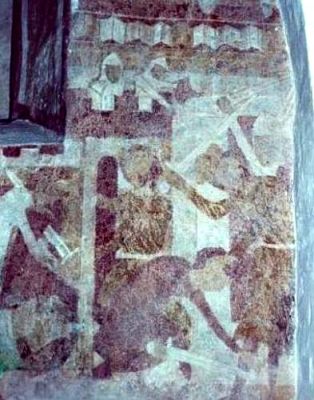
Fighting scene on fresco from around 1200 in Hornslet Church between århus and Randers. A group of warriors armed with swords attack a castle. At the top two defenders are wearing armor behind battlements. Photo kalkmalerier.dk.
He "let quickly the navy set out on the deep to meet the enemy, for now he would not serve God with prayers, but with weapons, and we cannot imagine anything God more pleasing sacrifice than the destruction of such wicked men."
Saxo continues: "However, it was less the thought of the Pomeranian to suddenly make an invasion of the enemy country than by sailing around soon here and soon there making fun of the Rygen peoples' riders that should prevent them from making their way into the country. When they saw the Danish navy, they believed that it was Borvin who rescued them with his people from the western part of Venden, because of the fog they could not see how many ships there were or how they looked like, nor could it occur to them that the Danes, who lived so far away from the Venden, could have arrived in such a short time, so much more that their scouts in their excessive security did not do their duty with sincere care."
Bugislav believed that the Danish navy was the fleet of the Rügen people and ordered that "one and a half hundred small ships were to encircle it, while the rest of the fleet formed battel order and anchored"; Bugislav threw anchor close to land, thus abandoning his mobility.
The Danes simply ignored the small ships and let them sail past. Saxo continues: "The enemy had yet to notice what they were doing, for the strong and persistent fog hindered him therein. As they got closer, however, the Danish youths could neither hesitate nor silence anymore, they hoisted the banners and did not refrain from giving their eager for battle by loudly voicing a song." It was an overwhelming Danish victory, however, some ships managed to escape."A innumerable number of them, who could not get away quickly enough, either because the ships were too big or because it took too long to get the anchors in, jumped overboard and would rather perish in the waves than fall by the sword." - "Eighteen ships were leaking as a result of so many streaming over into them and went to bottom with those who had sought to rescue from them." - "The Danes began, however, in their greed for making prey to be sloppu with the pursuit." - "The crews of almost a hundred ships gave up all hope of escape by sea and headed ashore, spreading unarmed and terrified in thick deserted forests." - "Thirty-five ships with the hostile nobility on board rowed everything they could pull to escape Absalon" - They lost "so much their courage that their fear completely overcame their sense of shame, and they went on to throw horses and armor overboard, thus facilitating the vessels to better be able to sail quickly, thus using the oars more eagerly than before, until they finally reached Peenemunde, where their persistent ended as they found a refuge there."
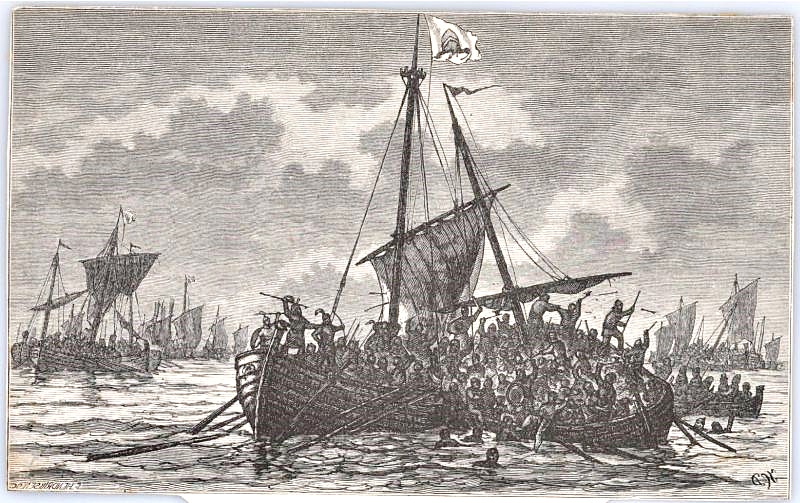
|
Absalon's battle with the Slaws off Rügen May 21, 1184. Drawing by F. Henriksen. Photo digital collections.
The battle is largely confirmed by Arnold of Lubeck: "Buggezlav therefore made landfall with several hundred Vikings at Geromar, and doubtless believed that he should devour all his land in the same way as the fire the timber of the forest. However, Geromar was not late to meet him and, despite his inferior combat powers, beat him in a trice on the run. The Danes had not far away put some warriors in ambush. The Slaws had no idea of treachery, but rowed to them, believing them to be their countrymen. Then the Danes jumped at them, joined by the Rugians set after them, killed some, intercepted others and forced several of them to abruptly plunge into the sea. For when the Slaws saw themselves encircled, they did not know what to do in their confusion; however, they hoped, as any other resort was barred for them, to escape by swimming, but drowned during the attempt in the waves. Others, on the other hand, reached the shore in their boats and then left them on the shore, but had to roam the forests and groves with swamps where they perished by hunger and thirst. On that day, the Lord paid them and now also let those, who had dragged so many Danes in captivity over the sea and the salty venture, themselves abducted into captivity and foreignness, whereby they came as slaves to stand under the same Danes, against whose freedom they still had schemed."
It is interesting that Jarimar and the Rügen people were firmly determined to maintain their connection with the Danish king.
The Danes won early dominion over the landscape of Tribuses, perhaps already in the time of Valdemar the Great. Saxo writes: "After sitting at home in the harvest time the king (Canute the Sixth) gathered twelve thousand Rügen warriors and passed through the area of Tribse, which lay under his rule." and Arnold writes about a time before the battle of Rügen: "However, Nyklot's party retained the superior power, since the powerful Germar (Jaromar of Rügen) greatly ravaged the land of the Circipans, which abutted the Tribuses." The sentence suggests that Tribuses had a special status. And later about a time after the battle of Rügen he writes: "But in the following winter, when the cold had laid an unusually thick crust over rivers and moors, Markgrev Otto gathered an army force and ravaged with Count Adolf's help all of Slavenland, sparing neither the Jeromar belonging land called Tribuses." Jaromar was Canute's loyal vassal of Rügen, therefore, we must believe that Tribuses was under Danish sovereignty.
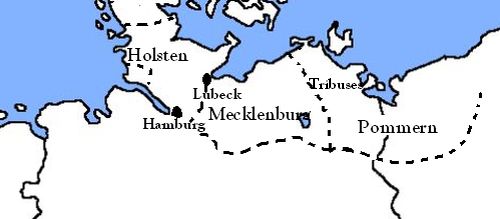
Canute conquered Pomerania, Mecklenburg and Holsten - in that order. The small area in western Holsten represents Ditmarsken, which belonged to the Danish king. Photo kalkmalerier.dk
Saxo says that after the battle of Rügen Absalon sent "a noble man from Fyn named Tage" to King Canute with the message of victory - bringing Bugislav's magnificent tent. Tage told of the victory and showed Bugislav's tent at Viborg Ting"and he did it such that everyone got the greatest desire to go out with the fleet."
The residents of the town of Volgast near Peenemunde had prepared for the attack by filling the sailing channel with stones, which made it difficult for the Danes with the big ships to get through. They had set up their siege engines in such a way that they had just aimed at the area with the stones. Absalon himself as the first one jumped into the water picking up stones, and the young people followed his example, thereby clearing the sailing channel.
The Danes filled a vessel with combustible materials and let it float against the city wall, but it was stopped by some of the many piles that the townspeople had driven into the water to prevent ships from getting close to the city, and it burned up without coming close to the town.
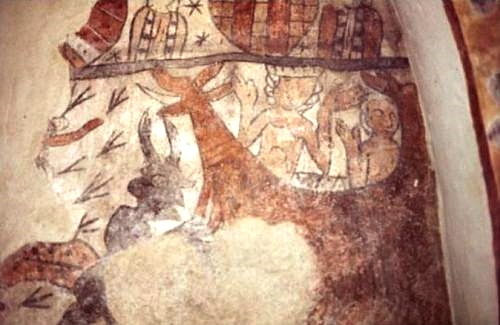
A fresco in Vester Broby Church south of Sorø, which may show Adam and Eve tempted by Satan in the form of the serpent, which here resembles a dragon or the Middle-earth serpent. Or it is the lost souls of the underworld on a kind of ship with dragon bow. Photo kalkmalerier.dk
Suddenly, Bugislav declared he would negotiate: "and, on the pretext that he would make peace, requested by his envoys a conversation with Absalon, and then went with a large group of horsemen to the appointed meeting-place. When Absalon met him with two ships, he asked him to go ashore, as they could more comfortably talk in a tent than on board a ship, he said." Absalom was about to disembark, but then "however, a noble Norwegian named Erling managed to hold him back by telling him a nasty dream he had predicting that the enemies would surely betray him". Instead, he invited Bugislav aboard his ship. "Bugislav then suddenly broke up again on the pretext that it was too cramped on board the ship, and so disclosed that he really had planned to betray".
The Danes abandoned to take Volgast after killing many enemies, who frantically ventured out of the city to plunder the Danes' tents. Instead, they set out to ravage the countryside. Esbern burned the Slaws' ramparts at Swinemunde. The king felt that it was too difficult to take the cities in which the Slaws had gathered large supplies. As they passed Swinemunde on the way home, he ordered "that what was left of the burned redoubts, should be razed to the ground, and to wipe out any trace of them he even let take the stones out of the ground and throw into the sea." It was precisely these redoubts that his father, Valdemar, in his last days had wanted to destroy. By this action, Knud demonstrated his loyalty to his late father.
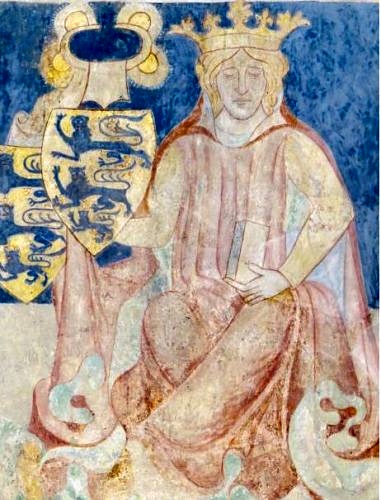
Canute the Sixth on mural in Ringsted Church. Here he does not wear the closed crown which he otherwise has on other frescoes and his seal. Foto Orf3us wikipedia.
In a subsequent raid the same year King Canute was alone followed by the Rügen people. Saxo writes: "After spending the autumn at home, the king gathered twelve thousand Rügen warriors and went through the countryside of the Tribse, which was under his rule, and then went, in order not to be inferior to his father over the marshes at the Peene river and came to the city of Lübkin.(?)" - "Then the Danes went back to their ships and then spread out to make loot and set fire, for the King had now because of the long way given up to attack Demmin."
Next year, the Danes returned, Saxo says: "After spending the winter at home, the King again with a large fleet headed into Swinemunde and destroyed Groteswin"(?). Tempted by the rumor of the Pomeranian wealth, they wanted to ravage the area east of the Pomeranian Lake: "It was said that the people were cowardly and female-like, and that there were few cities and weapons in the country, and as the Danes were accustomed to be followed by the luck in war, they burned with eagerness to leave in the hope of, that those, who had made so many lucky raids this time would also be followed by luck." but "As there was no food to be obtained along the way, not only the laden horses, but also the footmen, who had to carry the food became so exhausted that their powers failed them. The end of it was that they had to turn around and on the fleet go back to Julin."
Arnold of Lubeck describes the Danish strategy: "But the king of the Danes, Kanut, exercised incessant vandalism on the land of the Slaws. The latter, however, prepared themselves to fight back hard, occupied a shallow strait, which the Danes had to pass, built fortifications on both sides from which they could heap the Dane-vikings with spears and arrows, and also tried with iron chains to block this channel. But in spite of their severe deeds, however they failed, the Danes eventually found themselves with a high hand, broke down their fortresses, flooded their land as grasshoppers and filled all the land, so that the Slaws, unable to withstand their attacks, had to retreat to their castles. But the Danes robbed their countryside and sucked the marrow of the land, after which they returned to their own; and thus, for several years, they continued to make landfall both at the time of sowing seat and at harvest, ravaging their land and forcing them alone by the unbearable hunger without blows of the swords to surrender."
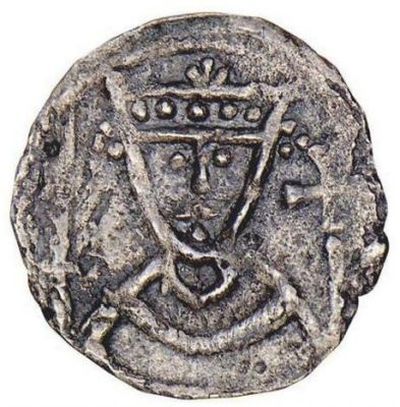
Canute the Sixth on coin. Here he does not wear the closed crown, as he does on some frescoes. Foto Wikipedia Commons.
Saxo continues: "The king now decided to attack Camin". The Sjælland and the Scania warriord first reached the city, as the others lost their way. They were attacked by Bugislav with great strength. The Danes lured the Slaws away from the city by pretending to flee: "Esbern, who had practice and experience in such things, urged the Danes to pretent to flee to lure the enemies far away from the city, and they also pursued the fugitives for a long time. Eventually, however, Bugislav realized that it was a trick of war, and he then called back his people, who were in complete disarray by running after the Danes, and over-poured them with reproaches, because in their carelessness they had ventured so far away from town. When Esbern saw it, he threw off the mask, gave up the pretended escape and turned his banners against the enemy, and so far he brought it that Bugislav jumped off his horse and, with anxiety and trembling, fled into the city again and trying to save himself by his skills in running."
Then the king arrived with the rest of the army. But then "came the clerics in solemn procession to him with their relics and bare feet as evidence of how broken and sorrowful they were, kneeling before him, begging him, reminding him of his pious father, at least to spare the churches and not burn the houses of God together with the houses of men; they begged him not to rage so cruelly against the enemies that he let the consecrated buildings of God burn, for by such a heinous crime he would waste all the good deeds both he and his ancestors had made. They added that Bugislav required safe conduct so that he could safely go out to the King."
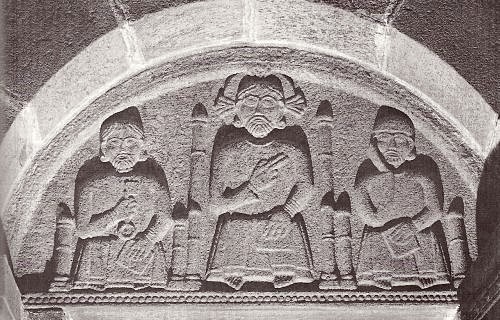
Relief over the doorway in Anst Church between Kolding and Ribe from 1150-75. Jesus in the middle and on his right Peter with the keys of heaven and on his left Paul with the Bible in his hand. Photo Lennart Larsen.
Bugislav had more confidence in the king than to Absalon. Saxo continues: "When Bugislav had been promised what he asked for, he sought Absalon and asked him to meet him the next day with Jarimar, for he wanted them to mediate peace between himself and the King." - "It was resolved that he should pay a large sum of money in fine, and he could only obtain peace on the terms that he should take his land which he had hitherto held as an ancestral inheritance as a fief of the king and exchange his freedom with bondage, as he, like the Rügen people, had to pay taxes. In confirmation of this agreement, he promised to deliver hostages."
"So that he should not be separated from them without he had been celebrated, Absalom made a feast for him and his friends, and in doing so he drank excessively and became so powerless and senseless." - "When he was completely dead drunk, he was carried from the ship into a tent, and Absalon commanded forty armed men to guard the entrance to the tent, taking care that nothing happened to him during the night." - "Bugislav appreciated this goodness so much that he made the Slaws friendly to the Danes."
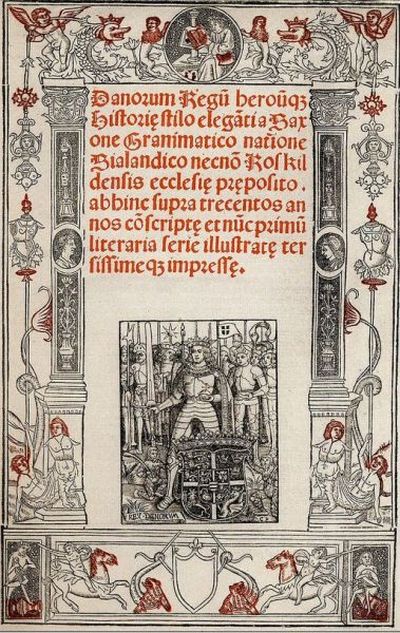
Cover page of Saxos Danorum Regum Heroumque Historia published by Christiern Pedersen in Paris in 1514. Saxo starts with the legendary kings Dan and Angel "from whom the Danish have their origin" and after thousands of pages ends with Bugislav's fidelity oath to Canute the Sixth - Everything carefully written on parchment with beautiful and regular handwriting. It is a unique achievement. But around 1500, he was nevertheless largely forgotten and his work disappeared. But Christiern Pedersen was convinced that a complete copy of the work had to exist, which he also succeeded in finding after a long search and getting printed in Paris, thus saving Saxo's work for posterity. Photo Wikipedia.
Saxo describes the famous scene in which Bugislav swears allegiance to King Knud and receives his land as fief from the Danish king: "On the following day he again met with the noble Slaw chieftains, threw himself as well as his wife and children at the king's feet, and humbly pleaded for forgiveness for the long-lasting rebellion he had instigated, and after he had given and partly promised to give hostages, he did not spare himself by taking the land his ancestors had owned as a fief." - "The king took pity on this prince, who distressed had pushed so far, and thought he had now being punished severely enough, which is why he raised him up, saying that he would rather bestow upon him the dominion over the land than incorporate it into his kingdom. And no less did the king feel touched for the sons of Bugislav, who on their mother's side were his kinsmen."
Saxo ends his long narrative describing Bugislav make oath of fidelity on the Danish royal ship. He says "Thus, Knud obtained with little trouble the dominion over Venden, which Valdemar had not succeeded in spite of his constant efforts, so that luck was his weapons even more favorable than it had been to his father's. At the same time, huge masses of clouds showed up in the sky, and there were so many thunderclaps that both the Danes and the Slaws were horrified by it."
Unlike Saxo, Sven Aggesen was in person present at the event: "This oath giving celebration I witnessed personally: it took place aboard the King's ship with the brilliant, golden trunks - not far from the city of which I have told that King Harald in his exile laid the foundation for."
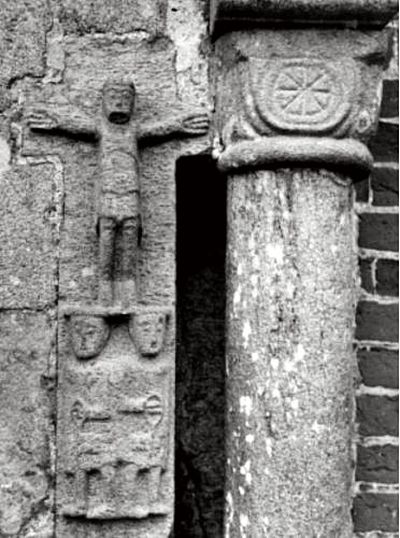
Romanesque granite relief from the 11-1200s in Sinding Church north of Herning. Under Jesus on the cross are two men, each with his own key. The two men have been interpreted as church guardians. Photo K. Helmer-Petersen.
Aggesen also talks about the thunderstorm which he refers to "the old rogue", which must be Thor: "When they had concluded the settlement, the clouds began to thunder, so one could believe that the World would perish. It was now probably an invention of the old rogue, the enemy of peace, which our Lord must have allowed him to perform; for during the torrential storm-shower and whirlwind it was just about that the Bishop of Camin and Duke Bugislav, as well as the King's brother Valdemar, a youngster with the most glorious talents - should have capzised in their boats."
The last words of Aggesen are: "After this action was completed, we sailed home with rejoicing and happiness; Let the Allmighty Master give it a happy and peaceful ending!
Arnold of Lubeck says: "Thus the empire of the Slaws sank; as taxpayers to the Danes, they had to thrall for these and furthermore give the castle of Wolgost and a dozen hostages in their hands. However, this did not go on without arousing anger at the emperor. This one announced that King Kanut had added to him a double offense, both by refusing to be crowned by him, and now by putting the Slaws, whom were imperial subjects, under the kingdom under his rule making them his taxpayers and loyal men."
By Henry the Lion's banishment to England, the emperor inaugurated a new duke for his possessions named Bernhard. He quickly became the enemy of a number of other German princes. Arnold says he had "no less foolish plans against the Counts Adolf, Bernard of Racesburg and Guncelin of Zverin. From Count Adolf, he namely sought to take away all the tract of land, which reportedly belongs to Ratekowe and had previously been Duke Henry's, as well as the town of Todeslo. He would also acquire the city of Lubeke." The said Counts already had a strained relationship with King Canute. "From the Count of Racesburg and Count Guncelin of Zverin he tried to cut off part of their fief." - "Enraged over this, both of them joined forces and set off to take his (duke Bernhard's) city, Lovenburg." Bernhard complained to the emperor. "But they (the counts Adolf, Bernhard and Guncelin), who wanted to shake off his (Bernhard's) yoke of their necks, sought to get those they knew were his friends, driven out of the country. They consequently assembled an army and fell secretly into the land of the Slaws; at night they secretly arrived in front of the castle of Ylowe, sneaked into it and got it in their power, while forcing the mother of Wertizlav's son Nyklot to walk away from it, and took all the others captive; the set fire to the castle itself, looted all the surrounding land, and returned, with ample booty, back to their own."
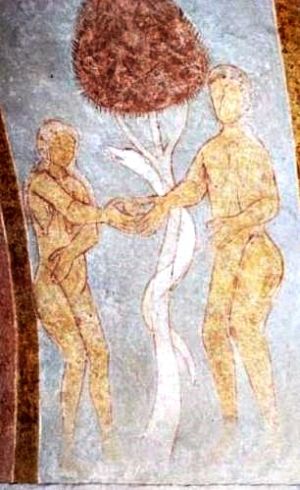
Fresco from 1100-1150 in Råsted Church northwest of Randers showing Adam and Eve, the snake and the tree. Photo kalkmalerier.dk.
Another Slaw prince named Burvin maintained the possession of his castles: "On the other hand, Pribizlav's son Burvin, who had a a daughter of Duke Henry by the name of Mektilda as wife, remained in possession of the castles of Rostok and Mikelenburg."
Nyklot sought refuge with the enemy of the above-mentioned counts, hertug Bernhard. Arnold continues: "From there he made numerous expeditions and practiced incessant vandalism against the land of the Slaws, supported therein by the Rugian prince Germar (Jaromar, King Canute's governor of Rügen)," - "while the Pomeranian Prince Buggezlav supported Burvin; thus these kinsmen lay in fraternal feud with one another."
Arnold continues: "And when Burvin, also called Henrik, once ravaged Germar's (Jaromar's) land, landing on the beach and robbed and plundered, he was taken prisoner by Germar, who had him thrown in chains and sent him to the king of the Danes, Kanut, with whom he was long held in detention." He probably attacked Rügen, which was Danish territory, so he was sent to King Canute.
His kinsman attacked Pomerania, but was captured by Bugeslav:: "On the other hand, Niklot, also called Nikolaus, was captured and thrown into chains by Buggezlav, in whose land he was collecting booty." It is not directly stated that he was sent to King Canute, he may also have been held prisoner in Pomerania by Bugeslav after he had sworn allegiance to King Knud. But the following events show that they were both kept in custody under Canute's authority.
Then the two cousins were released from their prison on condition that they took their land, which was probably most of Mecklenburg, as fief from king Canute. Arnold says: "Both of them, Burvin and Niklot, were kept in custody for a long time, but eventually released on the condition that they took their land as a fief from the King of the Danes and gave him the hostages he demanded. These amounted to twenty-four, and Burvin, among others, gave his own son and left the castle of Rostok, which he gave to his cousin, whereas he himself, according to the king's order, for he had every intention of subjugating the land of the Slaws and incorporating it into his kingdom, acquired Ylowe and Mikelenburg."
Magnus the Strong's son, Knud, who found his death in the blood party in Roskilde, had a son outside wedlock named Valdemar. Valdemar the Great had taken great care of his murdered fellow king's child. It was decided that he should have a spiritual career. Like so many distinguished young men, he was sent to Paris for the best education.
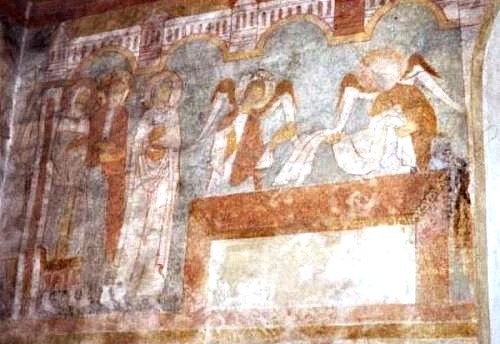
Frescoes from 1100-1150 of Jesus' resurrection in Råsted Church northwest of Randers. Mary Magdalene and Virgin Mary meet two angels at the empty tomb proclaiming Jesus' resurrection. Photo kalkmalerier.dk.
An Abbot Stefan in Sct. Genevieve Monastery tells in a letter about the good impression he got from the young Dane: he was early matured, acted with great dignity, but had at the same time a modest and pleasant personality, besides he had as good manners as he had been a Frenchman.
At a very young age he was appointed acting bishop of Slesvig. However, he could not be finally approved as bishop because canon law dictates that a bishop must be over 30 years old. He became real bishop in 1188, which indicates that he was probably born in 1158, the year after the blood party in Roskilde. Despite his young age, he is said to have led the Slesvig Diocese with great skills.
Arnold of Lubeck tells that "Bishop Waldemar was a very rich man as his fortune not only came from his bishop income but also from a huge inheritance from his father that had came into his possession."
Knud the Sixth showed Valdemar Knudssons great confidence by also conferring on him the worldly power in Slesvig until the king's brother, Valdemar (Sejr) grew up.
However, by 1187 the young Valdemar (Sejr) had reached the age of adulthood and therefore took over the worldly power in Slesvig as planned. It was very difficult for Valdemar Knudsson to be reduced to bishop again. He accused the young Valdemar of wrongfully depriving him of substantial estates.
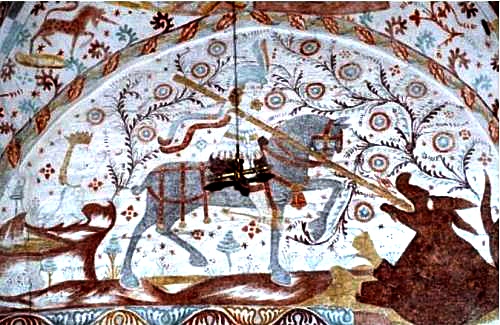
Mural of Sct. Jørgen and the dragon in Fanefjord Church. Photo kalkmalerier.dk.
In Germany, the battle between Henry the Lion and the Emperor was still raging. Arnold of Lubeck indicates on several occasions that the Danish king Knud supported Henry the Lion's party, and that was part of his motivation to refuse to swear fidelity to the Emperor. The battle between Henry and the Emperor began with Henry refusing to participate personally in the Emperor's war in Italy, a blatantly unwise action, as it is the chief duty of the nobleman to meet fully equipped when their King or Emperor calls. Why Henry did not want to wage war for the emperor, no one alive knows.
Henry the Lion returned to northern Germany from his exile in England and tried to regain his former position with the assistance of Archbishop Hartwig of Bremen. The attempt failed and Bishop Hartwig had to flee. As his successor, Valdemar Knudsson of Slesvig was chosen. Behind this bishop's election stood the enemies of Denmark, and therefore King Knud in Denmark responded by accusing him of treason. Arnold writes: "However, as a result of this election, Waldemar became suspicious for King Kanut and his friends. For as Kanut stood on a tense foot with the emperor, he believed that Waldemar had secret hostile thoughts."
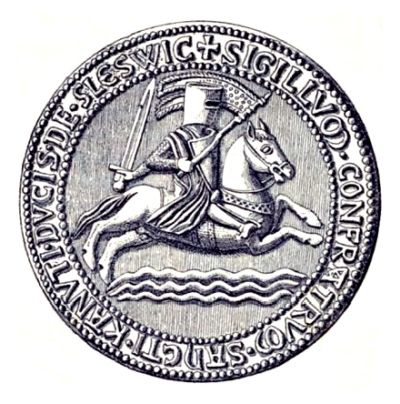
Slesvig Sct. Knudsgilde's seal from about 1220. The inscription reads: The Svorn brothers of Slesvig by Duke St. Knud. The knight wears barrel helmet which was the preferred type around 1200. Photo Docplayer.
However, in 1191 Valdemar Knudsson suddenly left Bremen and traveled to Sweden and then to Norway and negotiated with Denmark's enemies there. He was also supported by Count Adolf of Holstein and Bernhard of Ratzeburg. The following year, in 1192, he landed in Jutland at the head of a fleet of 35 ships and let himself proclaim king. Arnold of Lubeck says: "The son of the late King Kanut, Bishop Waldemar of Slesvig, had embarked on hostilities against the now reigning King Kanut to become king himself, and had gathered the help of the kings of Northwegia and Svecia, while on the other hand the emperor's friends, Count Otto, Count Adolf and Count Bernhard of Racesburk were him equally positive minded." At the same time, Adolf of Holsten broke into Slesvig with a considerable army, Arnold says "When Waldemar therefore led an army into the field against Kanut, Count Adolf, at the same time with a mighty crowd of people, crossed the river Egdora and ravaged the king's land all the way to Sleswik." He met too much resistance and returned to Holsten: "therefore he turned around to his own with big booty."
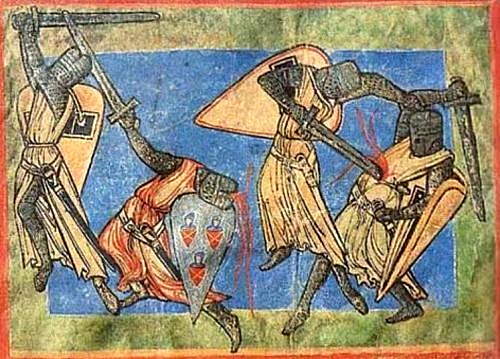
This is a loose page from Speculum Virginium (Jungfrauenspiegel) used to illustrate to young nuns the constant struggle between virtue and immorality. From the Kestner Museum in Hanover - Germany
Valdemar Knudssøn entered into a negotiation with the king, during which he was taken prisoner, placed in chains and put in Søborg's dungeon, where he should spend the next 14 years. Arnold says: "Indeed, Waldemar had been persuaded by some friends to resort to the king's grace as a kinsman and for the sake of old friendship to depend on the kings grace; this one would undoubtedly not hesitate showing him all the kindness he so highly deserved, and increase his reputation both with honors and with wealth. To such advice he relied, but in return had to tempt the volatility of luck, hard chained both on hands and feet."
But now the Danes had imprisoned an archbishop and it was a very serious matter in the Middle Ages. Hardly had it come to the attention of Pope Coulestin III before he wrote a letter to Absalon demanding that he and all the other bishops of the kingdom had to demand release and redress for the imprisoned Valdemar. But to the pope's great surprise, the Danish bishops supported their king and refused to declare the land in interdict. They insisted that when a bishop had broken all ecclesiastical laws and even been proclaimed himself king, he could not be forgiven. Abbot Wilhelm of æbelholt was assigned to travel to Rome and explain to the Pope that it was necessary for the kingdom's peace to keep the rebellious bishop in prison.
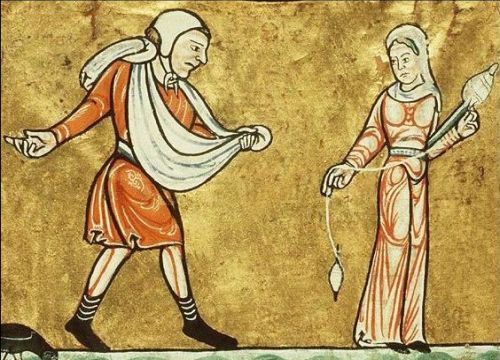
Illustration in French handwriting from 1180. The peasant sows and the wife spins. Photo Fécamp Psalter.
The Pope was tired of this case. In a letter to Valdemar Sejr he states that: "May he never have existed this bishop Valdemar of Slesvig, who violated the dignity of his episcopal office and sought to unite the priesthood and royal power in his person, and boldly initiated a conspiracy against your brother Canute, king of the Danes in renowned memory to whom he was bound by oath of allegiance." But he still thought it was his duty to work for Valdemar Knudsson's release, and in 1206 Søborg's gates were opened to him, in return for his promise to stay in Italy.
He did not keep his promise and before long he was back in Bremen, participating eagerly and ruthlessly in the political intrigues of the time.
Valdemar Knudssøn died in 1236 and thus became 78 years old, which was a very high age, the time taken into account.
In continuation of the episode with Valdemar Knudsson - perhaps in 1193 - Count Adolf of Holsten prepared to take on the Danish army. He had summoned his ally Field Count Otto as he feared he could not manage the entire Danish army alone. Together they awaited the enemy at the river Eider. But the Danes did not show up, and so Field Count Eight became impatient and returned home with his army. But then came the Danes. Arnold says: "Because, as I said, of such unrest, or, as some would know, to help Duke Henry, the King, with a corps of armed followers, moved into the count's land, and this one came against him, though of inferior force. For the count had long ago announced that the king would come, and had therefore not only called the field Count, but also gathered a mighty knight's army. When the king still hesitated to show up, the field count had left with many men; but suddenly the king came, and the Count moved out against him."
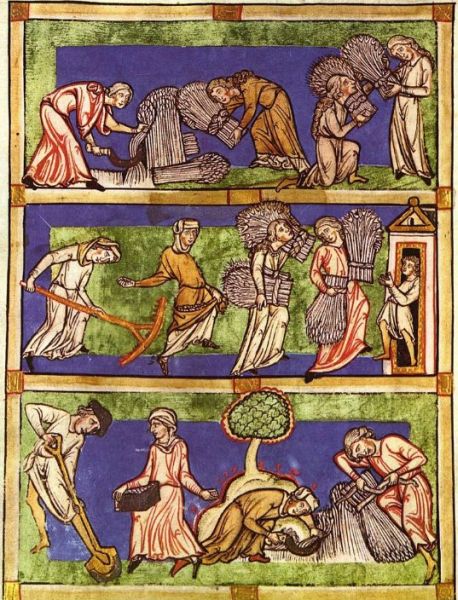
Illustration in Jungfrauspiegel from Trier from the late 1100's, showing the year's most important event, namely the harvest. The script was intended to introduce young women to life as nuns and shows the "three conditions for the woman": The virgins who dedicated themselves to Christ appear as reaping "a hundred times", the pious widows reap "sixty times", and the pious married women reap only "triple". Photo Wikipeia.
Count Adolf quickly realized that he was the Danes inferior, he asked for negotiations: "However, he calculated that he could not meet the king in open battle, so he sent him a mission to ask for peace. Thus he received the king's grace against paying fourteen hundred marks, and Kanut returned home to his place."
In the winter of 1198-99 Adolf further incurred King Canute's anger by together with his brother in arms Field Count Otto ravaging the land of the Slaws, who paid tribute to the Danish king. Arnold tells: "But in the following winter, when the cold had laid an unusually thick crust over rivers and moors, Field Count Otto gathered an army force and ravaged with Count Adolf's help all of Slaw Land, neither did they spare the land of Jeromar (Jaromar of Rügen who was Canute's man) called Tribuses, yes, they would have ravaged even Rugien itself, if not the ice, which was on the waters of the strait, were broken up. As a result of this story, the King's (Canute's the Sixth) anger fell heavily on Adolf, who, since that time, in general had made him an enemy. For the Count had more often offended the king, both by repeatedly attacking the Slaws, and by supporting the party of Bishop Waldemar against him."
The following summer, Canute raised an army, which he led against Holsten. But Adolf had foreseen the coming of the Danes and assembled a large army of allies, Arnold says: "So when summer was at hand, King Kanut led an army against Adolf to a place at Egdora, called Rejnoldesburk (Rendsborg). The Count met him with a countless number of warriors and was supported by Count Otto with a large number of armed men. There were Count Symon of Tekeneburk, Bernard of Wilipia, Mavricius of Aldenburk and many others present, just as Archbishop Hartvig of Brema was also not missing; and all these supplied Count Adolf for a period of not a few days at his own expense, to the great astonishment of many who could not undersand that the Count was able to pay the costs thereof. Thus the armies lay directly opposite one another with the river in between; but as neither the king nor the enemies had the courage to go over it and open the attack, the former at last broke up and went home again. And so this war ended without conclusion of peace."
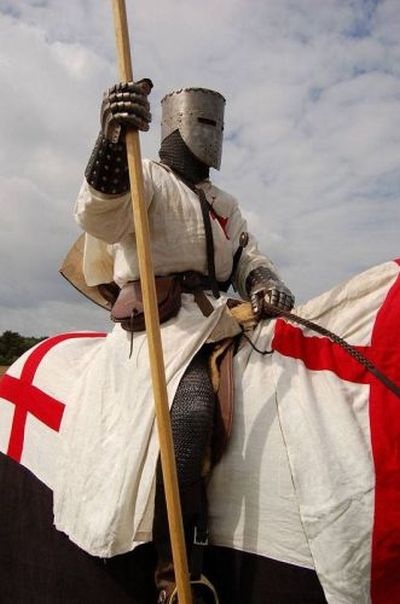
Reconstruction of armored knight with typical barrel helmet in Danish National Museum of Military History, Copenhagen. Photo topwar.ru.
Adolf knew that the Danes would surely come again. Arnold tells:: "As soon as winter was over, Count Adolf began to rebuild the old castle of Rejnoldesburk, hoping to secure himself against the king's attack. But this one, who could not forget his wrongdoings, gathered at the coming of the month of May the army and advanced with great strength to Egdora, where the Count also came with his people. As Adolf thought he could not withstand the king's attack, he succeeded in obtaining peace and being taken to his mercy of the king on the condition that he handed him over the castle, but was allowed himself to keep his remaining possessions in peace."
Canute used his new possession to build a bridge over the river Eider, so he was ready for the next half: "The king extended and fortified the castle and laid a strong crew, along with large weapons storage, let build a wide bridge over Egdora and thus had the road open to advance into the Count's country and out again, what from time to time gave rise to strife and conflict with this one."
But even with the back door open, Count Adolf still had an appetite for acts of war. Arnold says: "Nevertheless, the Count, in association with his namesake, Count Adolf of Dasle, began to attack Louenburk (Lauenborg) after having built the castle of Haddenberge, which thus closed for access to this so that the citizens there could neither escape nor enter" After some time "the castle men began, since foodstuffs was running out, to initiate negotiations about surrender of their castle and sent secret message to King Kanut to offer him the it." - "Pleased by the offer this one let them thank and and sent a nobleman from Holsacien named Radulf to there on his behalf to accept the castle". But the two kinsmen Adolf took the castle before Radulf arrived. "By the intelligence of this, the king was wise enough not to notice anything; but his hatred for the Counts thereby gained new nourishment."
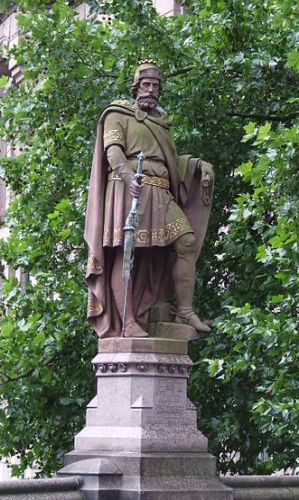
Statue of Adolf 3. Count of Schauenburg and Holsten at Trostbrücke in Hamborg. Photo GeorgHH Wikimedia.
Arnold says that the two counts Adolf had also attacked Ditmarsken, "that themselves had submitted to the King of Danes" - "having with his kinsman Adolf invaded Thietmarcien, who was thought to be under the king, and the two counts had plundered the land and killed not so few people."
Arnold says that the Slaws - in the year 1200 - after King Canute's order - with large forces attacked Count Adolf. The battle took place south of Ratzeburg in a place called Waschow: "However, at the instigation of King Kanut, Henrik, also called Borvin, and his nephew Nicholas, also called Niklot, launched an army campaign into Count Adolf of Dasle's land. The Count met them with his people at a place called Warsikowe. And after setting up their battle order, Nicholas opened the attack on the enemies and fell; he was a brave and wise man and the loss gripped the whole of Slaw Land so painfully that many found their death to avenge him. For when the fall of the great chieftain was rumored among the enemies, they doubled their attacks, killed the Teutons and felled so many of them that the Count himself only escaped with great distress only with some knights, seven hundred men had to leap over the blade, and the rest lost their freedom. "Alas, how so many grieving widows were sighing and crying!"
The king's younger brother, Valdemar, who was later to be bynamed Sejr (Victory), was then Duke of Slesvig. Supported by many, whom the Count had displaced from Holsten, he attacked the county in 1201. Arnold says: "But as all the better men poured into the party of the king and his brother, the Duke Waldemar, at the time of the day of the Exaltation of the Holy Cross, made an attack into the land of the Count with a strong force."
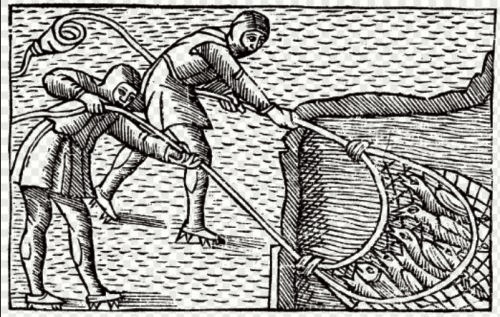
Olaus Magnus from 1555: Herring fishing in Skanør Two men pull seines. Photo Wikipedia.
Lubeck belonged partly to Count Adolf and partly to the Emperor. At the same time as Duke Valdemar's attack, the king seized the ships and property of the Lubeck merchants at the annual herring market in Skanør: "It was at that time when fishing used to take place in Sconia, and according to old custom many of our townsmen went there; these were now held back there with their ships and goods, yes, some of them even had to suffer jail."
In Holsten the decisive battle stood at Kirchengemeinde Stellau near Itzeho: "The Count met with his people the Duke at a place called Stilnowe. The battle stood; but the followers of the Count drew the shortest straw; many of them had to bite the grass for the sword, and others had to go in captivty. The Count saved himself to Hammenburk."
But Duke Valdemar continued to Hamburg and the Count fled. The duke "advanced into the country together with the wise and intelligent bishop Peter of Roskilde and, when the count had left completely, came to Hammenburk," where he received a brilliant reception: "Here the people flocked to him, and both the clerks and the whole people received him with honor." Duke Valdemar continued to Lauenborg, from where the other Adolf had already fled. The remaining people offered him "Racesburg castle and open access to the country". Duke Valdemar took several other castles and soon stood in front of Lubeck, where the inhabitants "decided, compelled by necessity, to rush the Duke into attendance; and they found him in Bredenvelde, and surrendered to him the city against getting back their prisoners and with them and the ships, and all the goods seized. The Duke took hostages both from the city of Lubeka as well as from the other towns and castles and went home happy."
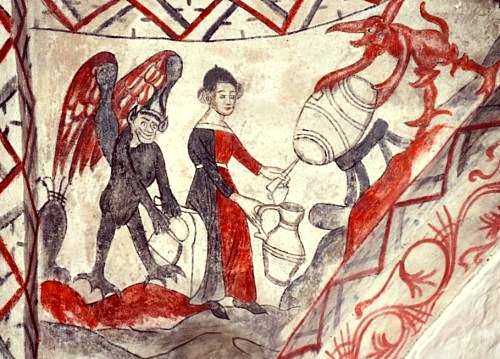
A fresco in Tuse Church west of Holbæk showing beer brewing as the devil's work.
Scandinavians have more than a thousand years of tradition of drinking at Christmas. In sagas and shell verses the term is often used "drink christmas".
Thus, when the Norwegian king Inge - in Håkon Hærdebred's Saga - received the message of Gregory's death, he regretted that he had not come to his aid in time: "But these people felt that nothing was as necessary as drinking this Christmas without interrupting it."
In The Saga of Bjorn Hitdalekæmpe states: "And because of Torsteins promise of friendship invited Dålk him to drink Christmas with them."
Fostbrødre Saga states: "Now they drank Christmas with great joy and a lot of amusement."
In Harald Fairhair's Saga the expression "He drinks Christmas" can be found in several places. Photo Facebook.
However, Count Adolf was not completely beaten, Arnold says: "Then Count Adolf of Skovenburk, out of anger over the loss of his land, gathered around the Blessed Andrea day ships and war crew from Stadium, which he was still holding, and occupied Hammenburk. Horrified, the king's and the duke's men and the bailiff Radulf escaped. Adolf still held the castles of Launborg, Segeberg and Travemunde, and many inhabitants pretended to believe that his case was not lost. They told him he could safely stay in Hamburg at Christmas "and fraudulently assured him that the Duke would in no case come because of Christmas, which the Danes have custom to celebrate with festive drinking parties." But on the very Christmas Eve, Valdemar came anyway, and the Count could not escape as the River Elbe was frozen. They "chained him hands and feet, led him not without dishonor him through all the places he had previously ruled, and came to Danien as a poor prisoner, and when the Danes heard that their enemy was captured, they proclaimed it like the Philistines of Saul's time in all cities and towns to the delight and joy of the hearts of everybody."
The king himself visited Lubeck and received a brilliant reception: "During the following summer, King Kanut came to Lubeke and was received with splendor and honors by the clerks and the entire population. On his arrival, the castle of Travenemunde was handed to him, which gave him not little pleasure. The rural population also flocked to him in and hailed him very willingly."
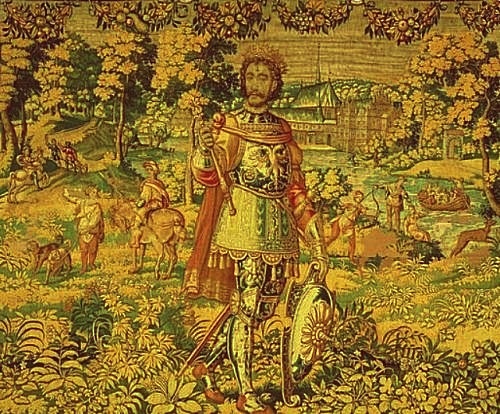
Canute the Sixth on one of Hans Knieper's Kronborg tapestries "Kanut, whose kingdom was characterized by the most utmost peace." He further describes the wealth of the Danes under King Knud: "They have begun to dress in scarlet and fur instead of their former sailor clothes." - "Wealth, of all kinds, they have in abundance as a result of the fishing they do annually in Skania." - "As a result of its rich pastures the land of the Danes has also full up with admirable horses." - "The nobles in the country send their sons to Parisii." Photo Arslonga.
In Canute's reign, peace and prosperity prevailed, that is, in original Denmark. The Abbot from Lubeck states that Kingdom of Canute "was characterized by the most utmost peace." Knud, however, continued his father's policy of ordering leding against the Slaws every single year, some years even several times. He "estimated, however, that in the days of his fathers the Slaws had caused many losses to his country; and as he saw that they had lost the assistance formerly rendered to them by Duke Henry, who had tamed their jaws with his dominion, he seized the opportunity to wage war on them." Except for some setbacks, he triumphed everywhere he came. He extended the Kingdom of the Danish King to Holsten, Mecklenburg and Pomerania.
Canute continued the expansion and strengthening of Danevirke defense rampart at the southern border that his father had begun.
Arnold has great respect for the Danes. He devotes an entire section to describe Denmark under Canute the Sixth,, "About the Dignity of the Danes"
The Danes had learned to dress according to the latest European fashion, most likely to Saxo's annoyance: "The Danes have, for so long, been living side by side with the Teutons, gradually learning to acquire their customs and suits both in their clothing and weapons after the other peoples; while in previous times they thus wore seamen's dress, as they, as coastal dwellers, were constantly romping around with their ships, they now a days are dressed not only in scarlet, brindlet and gray furs, but even in purple and linen."
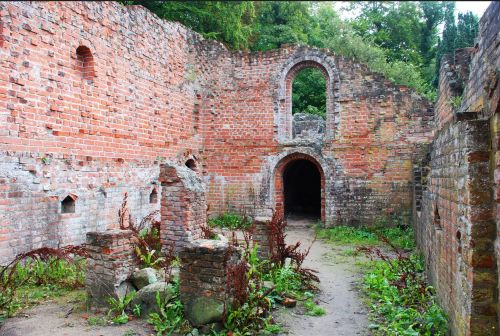
The ruins of Antvorskov monastery near Slagelse. It was built in 1170 by the Johanitter Brothers in Valdemar the Great's time. The Order of the Johanites operated hospitals and in addition, they had a military branch, which earned great fame in the fighting against the Muslims in the Kingdom of Jerusalem, Rhodes and Malta. The banner of the order is a white cross on red ground. They most likely participated in the campaign in Estonia during the reign of Valdemar Sejr, and it is possible that Dannebrog originated from them. Photo Billetexpressen.
Denmark is a rich country, he writes, because of the herring fishing in the Sound and the country's lush pastures. "For wealth, of all kinds, they have in abundance as a result of the fishing they do annually in Skania, on which occasion, from all the nearby peoples, merchants soon com to there in order to buy from the natives, which, by the generousity of God, compassionately flows to these, while the merchants give their best property, yes, even sometimes by shipwreck life itself only for a inferior commodity".
Danish nature and climate are well suited for breeding horses. We have lush meadows and mild winters, but never the less a climate that is cool enough to keep many diseases from the door. Throughout most of the known history the Danes have bred and exported horses. "As a result of its lush grazing pastures, the Danes' land is also fully stocked with excellent horses, which is why the natives use their stock of these animals to practice all kinds of knightly equestrian plays and they appreciate just as fully the battle on horseback as the battle on board a ship."
Arnold is impressed that the Danish great men send their sons to Paris for the best education. We know, for example, that both Absalon and Valdemar Knudssøn got their education in Paris: "In scientific education, too, they have made not little progress, the noble ones in the country sending their sons to Parisii, not only to raise the group of clergy, but also to have them educated in all kinds of worldly knowledge. There, they then acquire knowledge of the country's book world and its language, and thus they have driven it far not only in the free arts, but also in the science of God."

|
The part of the defense rampart, Danevirke, which is called the Valdemar Wall. Canute the Sixth continued his father's work to strengthen and expand Danevirke. To the left as the wall looks today and to the right as one imagines it looked at he time of Canute the Sixth. The Valdemars Wall was more than three kilometers long, six meters high and about 2.5 meters thick and built of "baked stone". Photo Mapio.net.
Arnold believes that the Danes are characterized by their eloquence: "Their innate eloquence enables them not only to show themselves as sharp heads, where in a dispute it is necessary to cope with evidence, but also in regard to the affairs of the church, to show their skills as dekretists and legists." Decretists are experts on canon law, and legists are experts on Roman law.
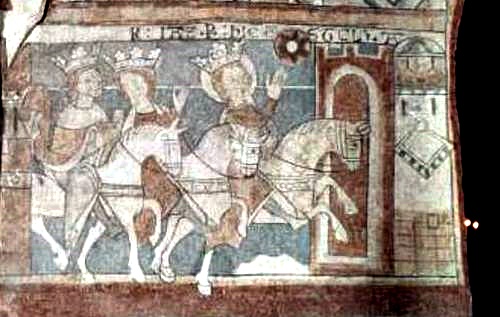
The Holy three kings in Keldby Church on the island of Møn. Photo kalkmalerier.dk.
Eskil had in his time arranged that all the international monks' orders should be represented in Denmark. In Canute's time, the monasteries in Denmark were inhabited by Johanites, Benedictines, Premonstratensians, Cistercians and Augustinians. Arnold writes:"With them, religion is in full bloom. For Archbishop Eskil in Lunden has in these parts of the country let built houses in big quantity for spiritually minded men and women of all orders. After Eskil, the lord Absalon took over the church government in his place, and, filled, as he was, with fiery eagerness for justice, and girded as he stood with the full armor of God, was not inferior to his predecessor at least in zeal for the advancement of religion."
Just around the year 1200, the citizens of the emerging cities began to join together in a kind of associations or fraternities called guilds. Each guild had a patron saint, very often Knud (Canute) the Holy, and they were therefore called Knudsguilds. The saint's help was secured by praying and decorating his altar in the church. Some guilds hired their own chaplain, who oversaw the daily masses for the guild brothers' salvation. He could have been paid by the income of the estades which the guild had acquired over the years.
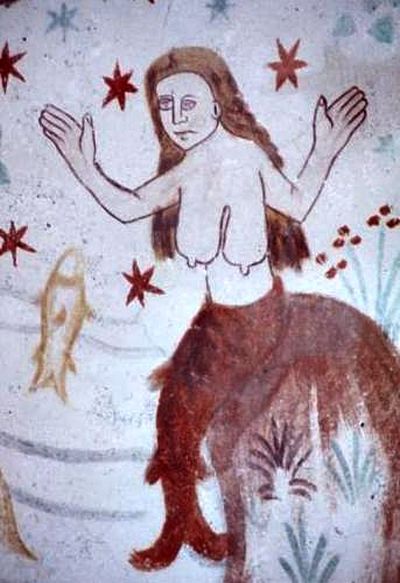
Fresco with mermaid in Fanefjord Church on the island of Møn. Photo kalkmalerier.dk.
Perhaps many merchants in the cities came from afar and therefore could not benefit from the solidarity and protection the extended family traditionally represented - or they came from less powerful lineages. This was surely an important motivation for forming guilds.
The duties and rights of the guild brothers were defined by a set of rules called a guild skrå.
The members of the guild had a social responsibility for one another very similar to that of relatives. If a guild brother's house burned, the others helped build it back up. If a brother became sick, the other brothers arranged someone to watch him, if one brother got poor he ate alternately with the others. If a guild brother was threatened on his life, he was followed by two armed brothers, where he stood and walked. If a brother was killed, his guild brothers had the duty to avenge him. The brothers had a duty to attend a guild brother's funeral.
It was probably members of Slesvig's Sct. Knudsgilde, who killed King Niels in Slesvig in 1134 as revenge for the killing of their guildmaster Knud Lavard. In Slesvig city law, they are referred to as "the sworn brothers".
Some hundred years later the craftsmen separated from the original guilds and formed craftsmen guilds. The original guilds became then reserved for the merchants. But the craftsmans' guilds never gained the same status as the merchant guilds.
The guilds can be called sworn associations because to-be members had to swear to abide by the rules as laid down in the group's "skrå". But they were not the only sworn associations of the early Middle Ages. Also, monks' and knights' orders demanded that to-be members to swear serious oath to abide by the rules of the order.
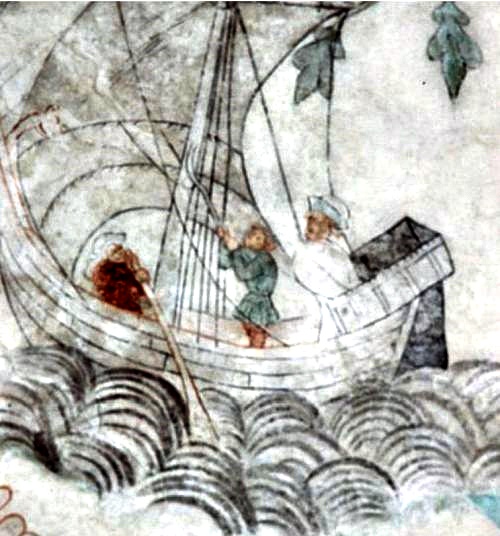
Fresco painting with a cog in Højby Church in Odsherred. Photo kalkmalerier.dk.
It is said that when Eskil as a young man studied in Hildesheim, Germany, he became ill and had a strange dream. He saw the Virgin Mary, and she promised him a high ecclesiastical position. He promised always to serve her in the future and gave her five bags of cereals of various kinds. A fellow brother interpreted the dream to that he should introduce five different monastic orders in Denmark. Peter Frederik Suhm believes that Eskil himself invented the dream. But Eskil really introduced in his time five different monk orders in Denmark, namely Benedictines, Augustinians, Premonstratensians, Cistercians and Johanites, who were still there in time of Canute the Sixth.
The order of St. John is interesting in that it not only fought for Christ in the spirit but also with weapons. The Johanites earned great fame in the fight against the Muslims in the Kingdom of Jerusalem, on Rhodes and Malta. The Johanites worshiped John the Baptist. The order emerged as a hospital order in the Kingdom of Jerusalem in the 1000's, very quickly they also formed a military department. Along with the Knights of the Temple, the Johanites or the Hospital Knights, as they were also called, were the most formidable military orders in the Holy Land.
After the Crusaders were expelled from the Holy Land, the Johanites defended themselves against the Muslim Turks in their castle on Rhodes, later refuting a similar siege of their castle on Malta. Together with a coalition of Spain, Italian city states, the Vatican State and the Duchy of Savoy, they defeated the Turks in 1571 in the Sea Battle of Lepanto, which was a turning point in the Europeans' fight against Turkish expansion.
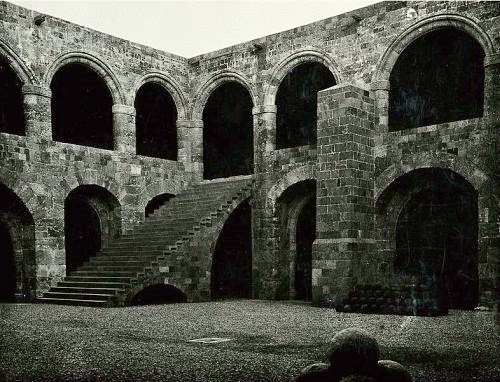
The courtyard of the Johannite fortress on Rhodes. Photo Wikimedia Commons.
However, sworn warrior-communities were nothing new in history. Harold Bluetooth founded about 970 the Jomsvikings, an elite corps of warriors between the ages of 18 and 50, who had their own laws. One must think that new recruits had to swear to obey these laws, help one another and obey their leaders.
At the end of the Jomsvikinge Saga, two groups of "Thingmannalid" stationed in Lunduneborg and Slessvik in England are mentioned around 1015. The tingmen were governed by their own laws, which included no one to spread uncertain rumors, no one to be away at night and every night at three o'clock they should go to church without weapons.
In the time of Saxo, Svend Aggesen and Absalon, it must have been a perfectly obvious idea that the king's men should be organized in a similar fraternity governed by their own rules and laws and with the king as the first of the equals. But they couldn't just say they had got a good idea and that is how they thought it should be. It should be reinvented from the venerable past. It is said in one edition of Vederlaw: "Although it is in the king's power to issue or change laws, we do not issue this law as a new one; rather like a law created in ancient times, which has been hidden by the clouds of ignorance, and which we recall human memory, darkened by many past years, which is the mother of oblivion."
Saxo, Svend and possibly Absalon described in detail the laws of Knud the Great's elite corps called Tingmannalid or the Tingmen.
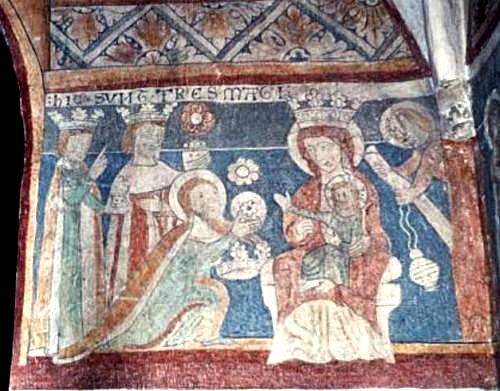
Mural from 1275 in Keldby Church on the island of Møn. The Holy Three Kings worship the Jesus-child. Photo kalkmalerier.dk.
The Vederlaw is described in at least three versions, one by Svend Aggesen, one by Saxo and one or more versions in Danish, which may have originally been written by Absalon and King Canute. They are all different, but Aggesens is the most elaborate.
Saxo explains why it was necessary to have such a law:: "There were many warriors flocking to Canute, and they were probably as troublesome in their minds as the wages he had to pay them. For most of them had more physical strength than good manners, and those who had distinguished themselves in war contemptuously looked down at what was decent in peace, so that those who were excellent beyond the borders of the country seemed nasty at home, and there was hardly anyone to find, who was both a brave man and a decent man. Therefore, several were also downright harmful to have in the royal household due to their violence and bickering. As the King perceived that they were so vastly different in regard to national origin, language, and mind, because they were driven by different and contradictory inclinations, some of playfulness, some of envy, and some of anger, he issued an exceedingly useful law of the household troops, that could end the flow of disagreements due to so many differences and teach the warriors what was right and proper."
The Vederlaw gave very detailed rules for the conduct of the warriors in the king's household. For example, the penalty for treating a mate's horse inferior to his own might be to placed one seat further down at the king's table. Repeated offenders could be benched furthest away from the king and might tolerate their comrades throwing their gnawed bones at them if they pleased - such as Rolf Krake's warriors threw bones after Hjalte. The warriors should "obey the king's orders, just as limbs obey a head". But the king "should himself show the loyalty he demanded from them. He was to present a cheerful face and not deny any of them a polite reception. He was also to give them wages for their work and pay his warriors their wages without delay or any argument."
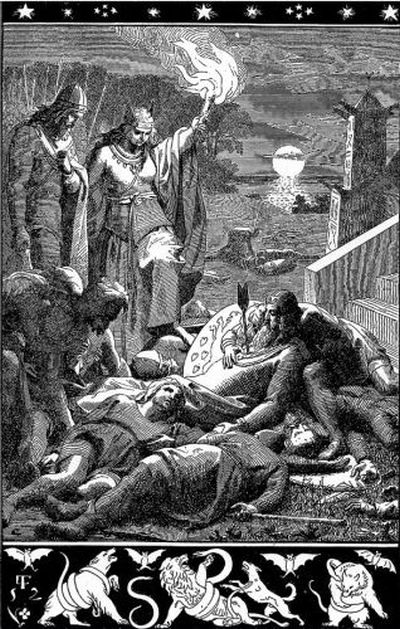
The bodies of Rolf Krake and his men after the battle. The great poem, Bjarkemal at Saxo is a dialogue between two of King Rolf's warrios, Bjarke and Hjalte. They fall after fighting to the end for their generous king. The story of Rolf Krake and his household troops is a Scandinavian King Arthur legend. Rolf Krake's household troops fought to the last man to defend their king. So did Canute the Holy's men in Odense and King Niels' warriors in Slesvig. Drawing by Lorenz Frolich 1856. Wikipedia.
Violations of the laws of the hird were to be dealt with at a joint "housecearl meeting" led by the king.
Svend Aggesen emphasized very much that members of the hird should come from the country's most distinguished families. He says that old King Canute: "wanted to have a closer relationship with those whom he knew were justified in claiming noble descent, and who could rejoice in abundant wealth, so that those who came from more noble families should try to excel in virtue" - "Therefore, he proclaimed that only the men who honored the king and adorned their weapons with shining impressively gilded axe-heads and sword-handles should come nearer to the gentle king and have the privilege of a closer association." - "For it would create honor for the prince, if a distinguished flock escorted him if he was accompanied by a guard of brothers in arms." It is clear that Aggesen wanted only the sons of the kingdom's leading men to serve in the king's household. Like the knights of the round table in the King Arthur legend, which precisely became popular at this time, they sat around just a round table so that they would all be equal, even though the king was more equal than others.
We note that it is completely opposite to other European rulers. The pope surrounded himself with a life guard of Swiss peasants, and the Eastern Roman Emperor of Constantinople secured himself with a life guard of ax-armed Scandinavian warriors, who came from quite far away. The pope and the emperor did so because they did not want their lives and their power to be in the hands of men, who had interests in the local intrigues of power among their subjects. Their life guard should depend only on them personally. But the Danish kings surrounded themselves with their own countrymen, whom they assumed had a good motivation to defend the King and the Fatherland.
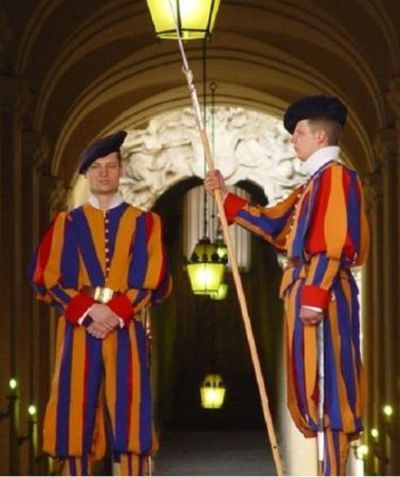
The pope did not recruit his bodyguard from Rome's distinguished families. He employed peasant sons from the Swiss mountains, who had no part in the political intrigues of the Eternal City. Photo Escapeaway.
The Historian Hal Koch believed: "We stand here at the origin of the nobility or the domination of the "herremænd" (Danish for nobility, it means literaly "master men"). There has been disagreement about the meaning of the word "herremand". Some have wanted to put it in the context of the word "army" (hær) so that its basic meaning should be "warrior". However, it is likely to mean "a master's man", one who serves a master to whom he is associated with the oath of allegiance and certain obligations, first and foremost war service."
Koch continues: "It is not only the king, who in this way could "take men". About this is stated in the Jutland Law (1241): "The king may take men everywhere in his kingdom, in whatever skipæn he wishes, and the duke in his duchy, but others of the king's children or kinsmen or counts may not take men except in their own area or county, and the bishops shall not take men outside their bishopric."
As the nobility were available as warriors for the king all the time, they were exempted from the leding system, according to which the peasants should only meet when leding was ordered. But in the course of history, the leding system developed so that it was possible to pay a tax instead, and in the course of time it became solely a tax that rests upon the peasants. From this came the nobilty's tax exemption.
As a young man Absalom had studied in Paris and made friends with the kannik Wilhelm. Later, Absalon invited Wilhelm to Denmark to become an abbot at æbelholt Kloster west of Hillerød. Wilhelm was a knowledgeable and gifted man, who became a great asset to Denmark. Perhaps in one of his many letters to his friend, Brother Bernhard of Vincennes - who was an adviser to King Philip August - he referred to King Valdemar's daughters.
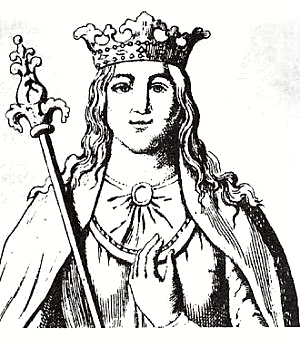
Ingeborg on the drawing of a now vanished copper relief on her grave. According to all sources, she was a beautiful woman. She was daughter of Sofie, a celebrated beauty, and Valdemar, who was also described as a beautiful man, so it must be true. Daughters often look like their father, and Valdemar was a tall man, and she may have been tall too. Drawing from "On the trail of Ingeborg" by Lizette and Alfred Nielsen.
In 1193, a delegation from the French King Philip August arrived to ask for Princess Ingeborg's hand. She was about 17-18 years old then. The motive for this marriage was very much political. Philip August wanted help from the Danish Navy in an attack on England. He was very interested in the old Danish claim to England, which dates all the way back to Sweyn Estridson. Canute the Sixth wanted French support against the emperor. Denmark could not commit to an attack on England, yet the wedding conditions were agreed, which included a dowry of 10,000 marks of silver.
The wedding took place in Amiens on August 14 of the same year. The next day the coronation was to take place under great splendor, but already before Philip August should have shown his reluctance against Ingeborg, and during the very act he became deadly pale and had convulsive seizures, but the ceremony was conducted. Shortly after, the king asked the Danish delegation to take Ingeborg back to Denmark. According to the king, on his wedding night, he had been deprived of his potency due to sorcery. But Ingeborg refused to give up her rights as Queen of France.
Later that year, Philip August filed a divorce lawsuit alleging too close kinship between Ingeborg and his formerly, now deceased wife, which was a claim out of thin air. Abbed Wilhelm drew up a genealogy which disproved this and together with the king's chancellor he went to the pope in Rome to speak Ingeborg's case. The Pope declared the divorce invalid. They traveled to France and presented the Pope's decision to Philip August, who, however, rejected it.
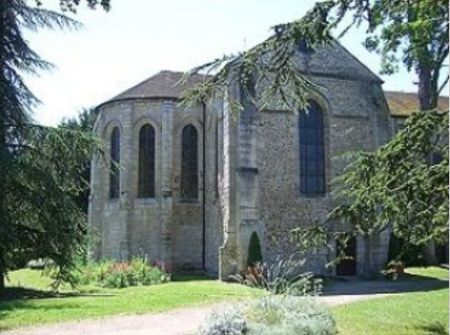
Church St. Jean in Corbeil, which Ingeborg had built together with the Order of the Johanites. She is also buried in this church. Photo Things to do and see in Corbeil-Essonnes.
King Philip August repeatedly pressed Ingeborg to take the veil and become a nun, but she refused stubbornly. In addition, she had to endure a new humiliation, as the king married a duke's daughter. After the wedding, Ingeborg was relegated first to the Monastery of Saint-Maur and then to Cysoing near Lille. A new pope, Innocens III, took up the divorce case again in 1201, and Philip August felt the defeat and waived the claim for divorce. However, it did not lead to Ingeborg being reinstated in her rights, on the contrary, the king let her take to the castle of Etampes south of Paris, where she spent twelve years, the first six as prisoners in the bottom of the tower.
She managed to get a letter smuggled out to the pope: "You must know Holy Father that I have no relief in my prison, but suffer countless and unbearable transgressions. For no one dares to visit me there, as little as any monastery person to come to comfort me, nor can I hear the word of God, as little as I have access to confess for any priest. Sometimes I get too little food, I enjoy daily the bread of sorrow and the drink of affliction, I get no medicine to cure human frailty. I am not allowed to wash myself. If I want to be seen by a doctor, it is not allowed, and so I fear for my vision and for being overwhelmed by serious illnesses. There are not many clothes, nor are they of such a kind suitable for a queen. I will not be able to present my hardships in detail, because what should not be denied to any Christian woman is denied to me, and what should not be done to any despicable person happens to me. Both because of these and similar things that I am not currently able to describe for you, Holy Father, I feel that I, the haunted, fell disgust by life."
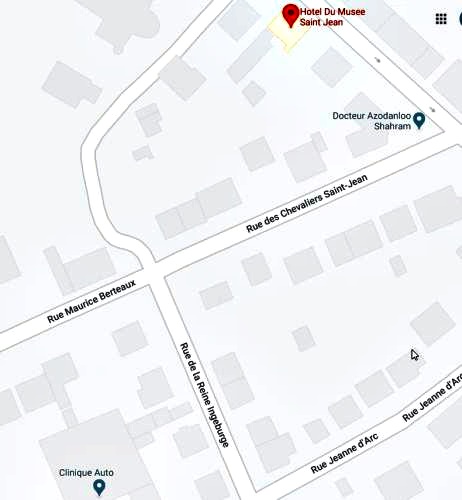
Behind the Church St. Jean in Corbeil, where Ingeborg is buried, runs Rue de La Reine Ingeburge, which means Queen Ingeborg's Street. Photo Google maps.
Later Philip August needed to improve his relations with the Pope and therefore he gave Ingeborg more bearable conditions higher up in the tower, but she was still a prisoner.
Ingeborg actually became free only in 1213, twenty years after her wedding, where she again received full Queen rank, which was due to new political constellations in connection with the pope's hostility to England. She did not se her husband much, but the rest of the royal family was devoted to her.
She had not forgotten her homeland and sent relics home. When her brother, Valdemar Sejr, fell into captivity, she made a huge contribution to the ransom. In collaboration with the brothers of the Order of the Johanites, she commissioned a large project in Corbeil with a hospital, a church and an advanced farm.
At his own request, she was in 1237 or -38 buried in the church of St. Jean in Corbeil.
Canute the sixth son of King Valdemar the Great and his Queen Sofia, the daughter of Prince Volodar of Minsk and half-sister of that Knud Magnussøn, who died in the blood party in Roskilde.
Knud was only 14 years old, when in 1177 he married Henry the Lion's daughter, Gertrud, who was considerably older than he and a widow of Emperor Konrad 3's son Frederik of Rotenburg. Unlike many other Danish kings, Knud did not have lovers, he stuck to his wife. Arnold writes: "Thus he did not, as the youth otherwise have custom, run after games or plays, nor was he keen to make excursions or strolls, not devoted to do excessive things, but "chaste himself with his chaste wife he lived his days.". Queen Gertrud died in 1196, six years before Knud, and their marriage was childless.
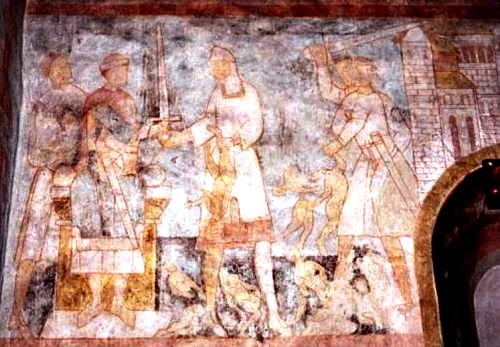
Fresco from 1134 of the child murder in Bethlehem in Råsted Church west of the Holsterbro. Photo kalkmalerier.dk.
After the fall of Henry the Lion, Valdemar the Great met with the Emperor in Lubeck, where they discussed the possibility of a marriage between the Emperor's son and one of Valdemar's daughters. Saxo says: "When they met at the agreed location, the Emperor began to talk about his sons' marriages and demanded thirty thousand marks in dowry with the eldest of Valdemar's daughters and eight thousand marks with the youngest. The Danish chieftains now immediately suspected that there was fraud behind this demand, since neither of the two girls was yet of married age, and Valdemar, who believed that the greater of the said sums was more than he could overcome, confined himself to promising to do the least" - "This agreement was sworn, and the promise of marriage confirmed with the oath of both parties. When this was done, the king returned to his ships and the emperor to his camp."
But, however, Valdemar died soon after and it was up to his eldest son Knud to arrange his sisters marriages, and Knud was not nearly as interested in a good relationship with the emperor as his father had been. Arnold says: "At the same time, the emperor sent reputed envoys to King Kanut for the rest of the money which his father Waldemar had promised the emperor's son in dowry with his daughter, and which Kanut had also partly paid. But because of the misunderstandings which, as stated above, happened between him and the emperor, the king hesitated to pay out the money."
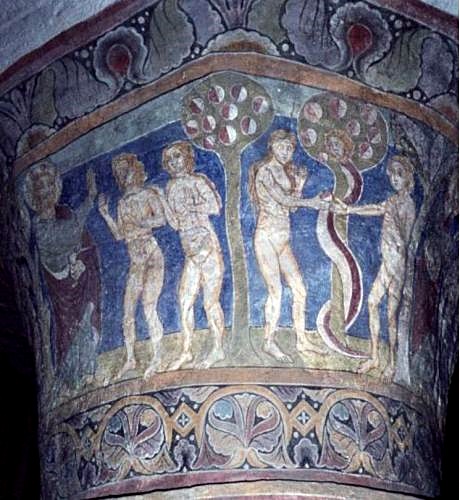
Fresco from 1225 of the fall in Nylar's Church near Rønne on the island of Bornholm. On the right, Eve hands the apple to Adam and on the left they are admonished by God. Foto kalkmalerier.dk.
The emperor did not hesitate to send Valdemar's daughter back to Denmark: "The emperor then sent the king back his sister, intact and with the same equipment that she had previously brought, not because he seized the opportunity to insult her, but because the agreement was broken. This angered Kanut, and from that day he began to practice open enmity against the emperor, declaring that all the land of the Wagirians, Holtsatians, Sturmarians, and Polabians rightly belonged to him until Albia, and he let regularly the Slaws, whom he had attached to him, ravage that area."
Valdemar's widow, Canute's mother, Sofie, remarried - after eight child births - with the emperor's sister's son, Count Lothewig. Arnold tells: "At the same time, the Emperor's sister's son, Lothewig count of Thuringia sent away the wife, he had hitherto, using too close family connection as a pretext to divorce, after which he took the Dane king Kanut's mother in marriage. When she with many treasures and rich household effects had left her homeland, the Count met her at the river Egdora, received her by the hand of the King and his bishops, and then went his own way with joy."
But the joy lasted only briefly. Arnold continues elsewhere: "Also his (Canute's) mother was send away by Count Lothewik and had to return to her native country without honor, complaining that she had been offended by her husband in many ways. This angered Kanut even more and strengthened him in the idea that he was in his good rights against the Teutons." It happened at about the same time that the Emperor sent Canute's sister back, and these two events must be linked to a deterioration of the relationship between Denmark and the German-Roman Empire.
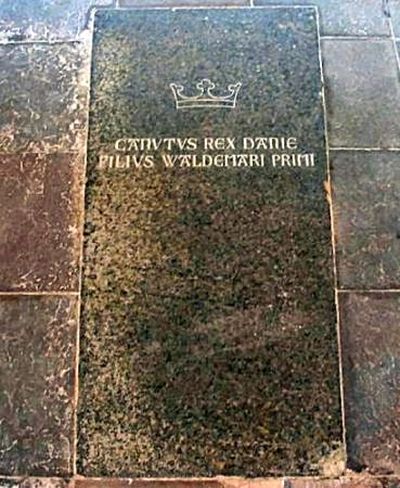
Knud the Sixth's tomb in Sct. Bendt's Church in Ringsted. Photo hos på gravsted.dk.
At Canute's death, Knytlinge Saga, Snorre's King's Sagas, Saxo, Svend Aggesen and Helmold had all completed their stories and their writers had put down the pens. Only Arnold of Lubeck tells of the king's death: "After the duke had let this (the fortress Sigeberg in Holsten) occupy by his men and was about to travel home to his own, he was surprised by the sad news, that his brother, the king, was dead and deeply shaken by the message he hastened further his return to receive his brother's kingdom. With great consensus he was then elected king, received at Christmas time the crown in Lund by the present Archbishop Andreas and was placed with splendor on the royal throne." The Duke of Slesvig was King Canute's little brother, Valdemar, who should get the byname Sejr (Victory).
Canute the Sixth died in 1202 and was buried in Sct. Bendt's Church in Ringsted. He was king of Denmark for twenty years. He was not as colorful as his father, Valdemar the Great, and his successor, the brother Valdemar Sejr, in that there are no myths and folk songs about him like about the other two. He was a wise and effective king - good at choosing the right advisers - internationally respected, though not always loved, especially not by the emperor. His reign was a golden time for Denmark both politically, culturally and economically. Knud became about 47 years old.
|
The Works of Svend Aggesen Vnsrweb Kalkmalerier.dk Kalkmalerier.dk Arnold af Lybeks Slavekrønike Per Benny Paulsen Danskernes internationale ry for at være drikfældige stammer fra Middelalderen Videnskab.dk Svend Aggesen Heimskringla Knytlinge Saga Heimskringla Saxo Grammaticus Heimskringla Die Slawen, Teil 1: Ihre Geschichte Morgenwacht Die Slawen, Teil 2: Alltag, Wirtschaft, Religion Morgenwacht Venderkrøniken archieve.com Venderkrøniken Crassus Saxo Grammaticus oversat af Fr. Winkel Horn - Sesam 1994. Snorre Sturlasson Kongesagaer - Nationaludgaven 1930. Danmarks Historie 4 Kirker Rejses alle Vegne af Ole Fenger - Gyldendal 1989. Valdemarerne af Palle Lauring - Gyldendals Bogklub 1973. Danmarks Historie bind 3 Kongemagt og Kirke af Hal Koch - Politikens Forlag 1963. "På sporet af Ingeborg" af Lizette og Alfred Nielsen i Skalk no.5 1983. |
| To top |